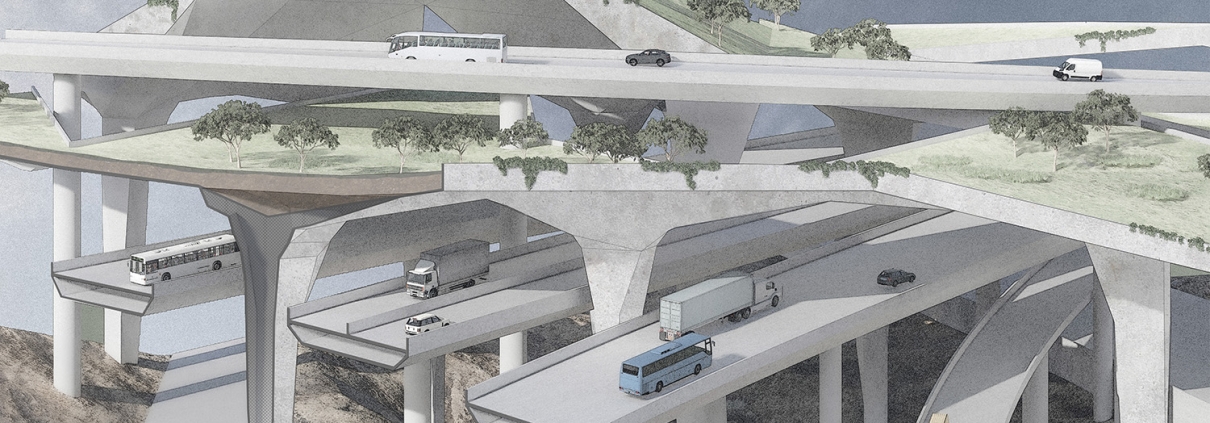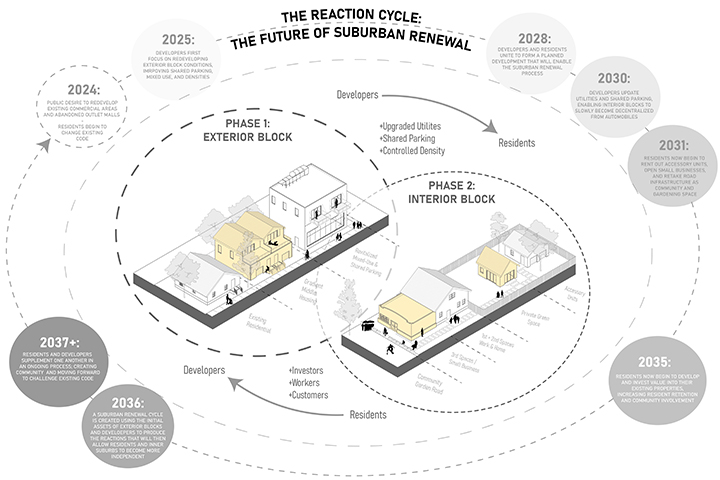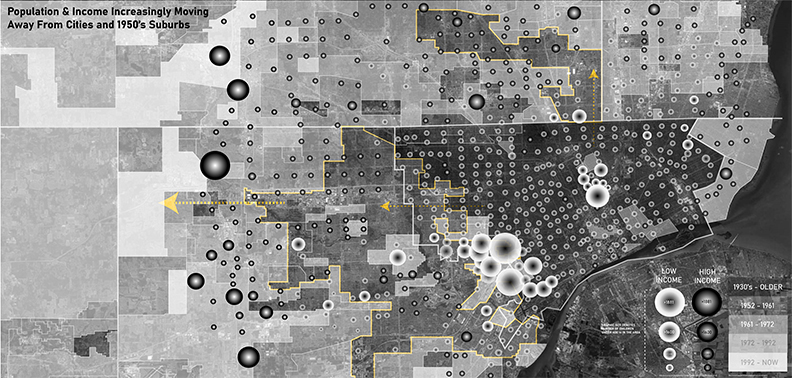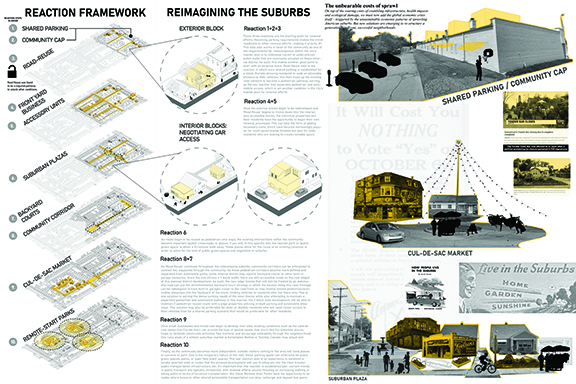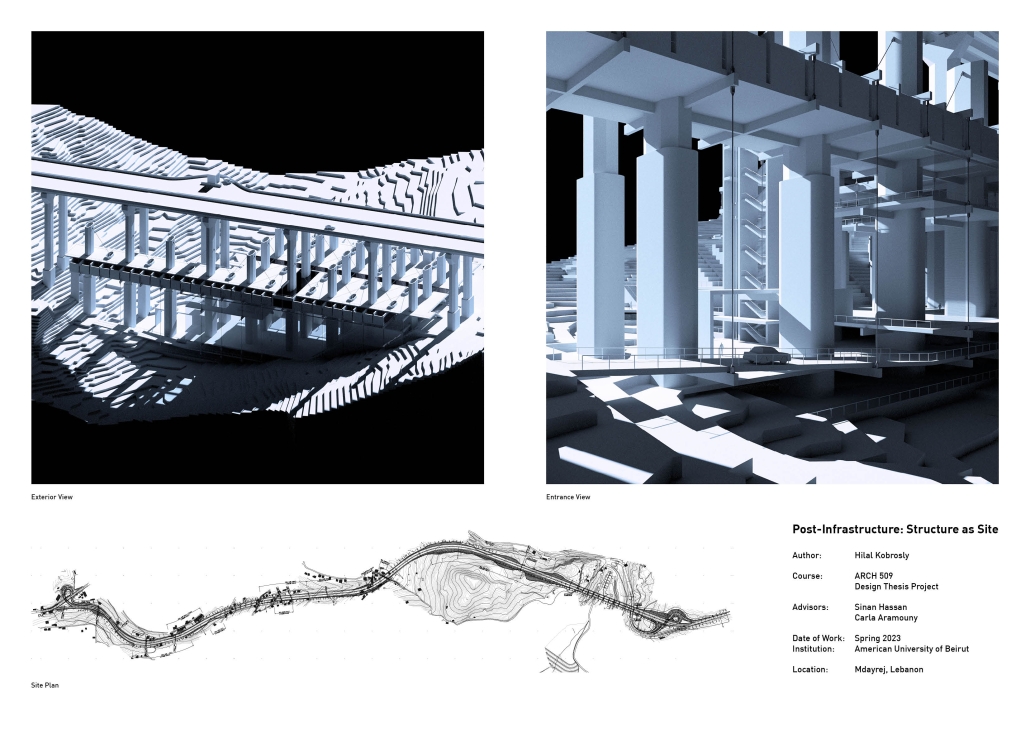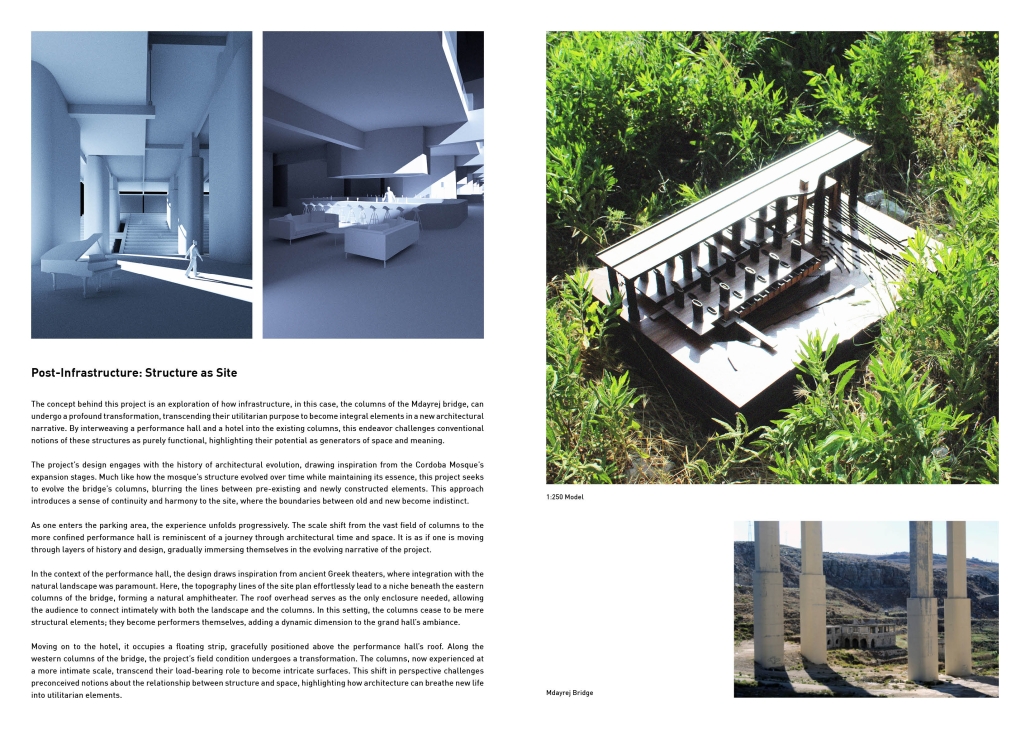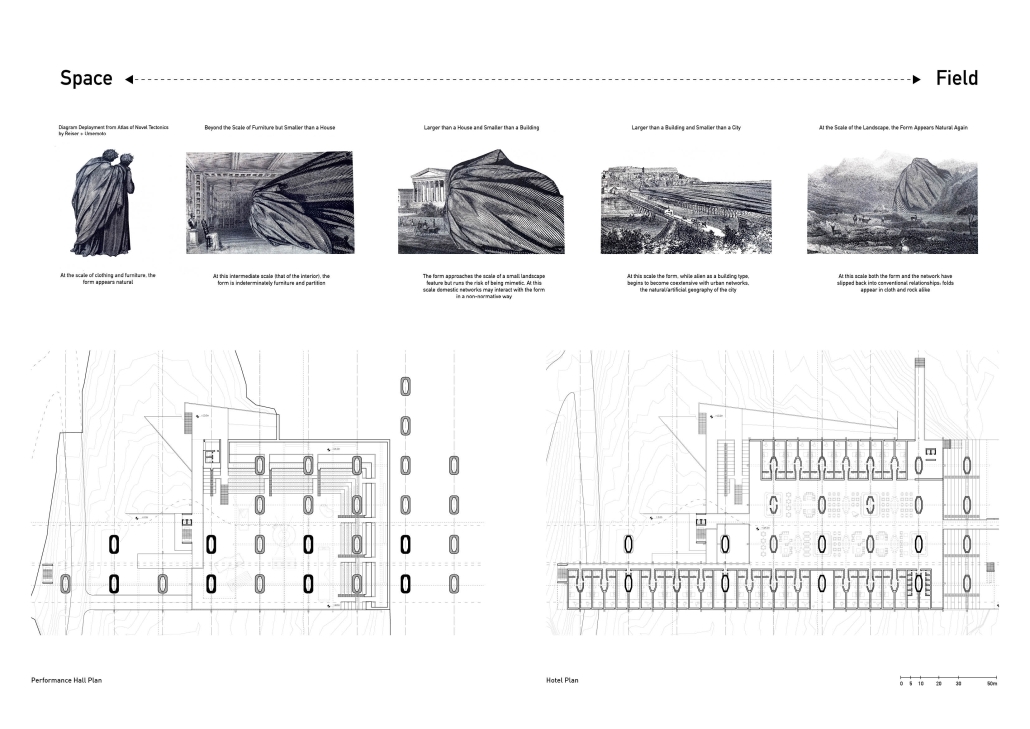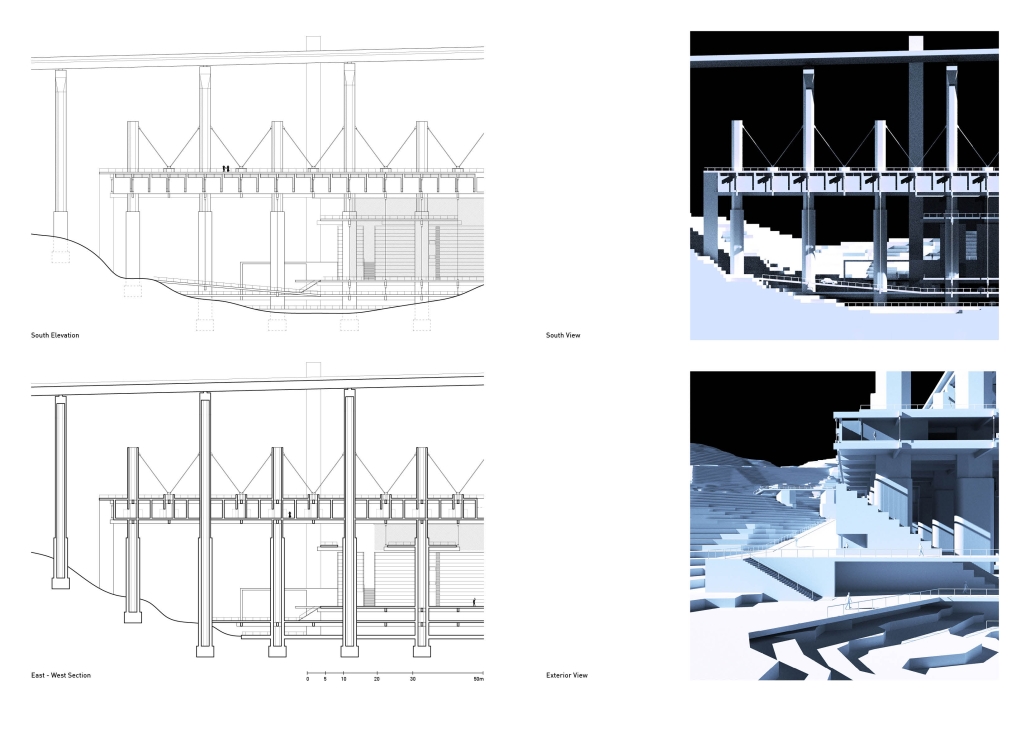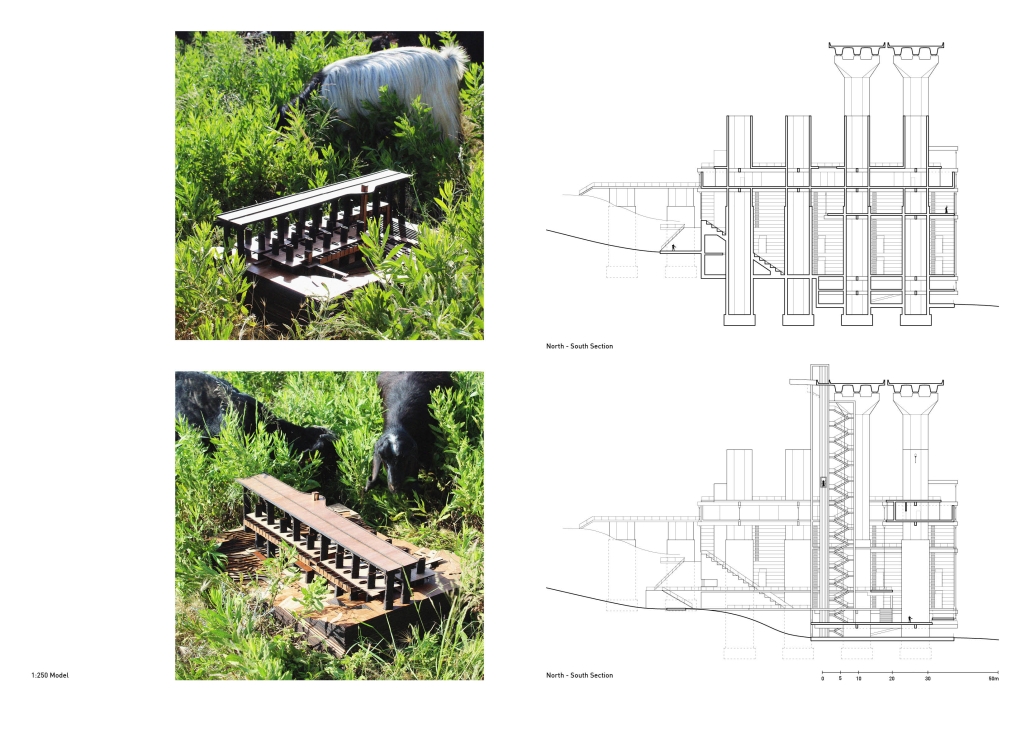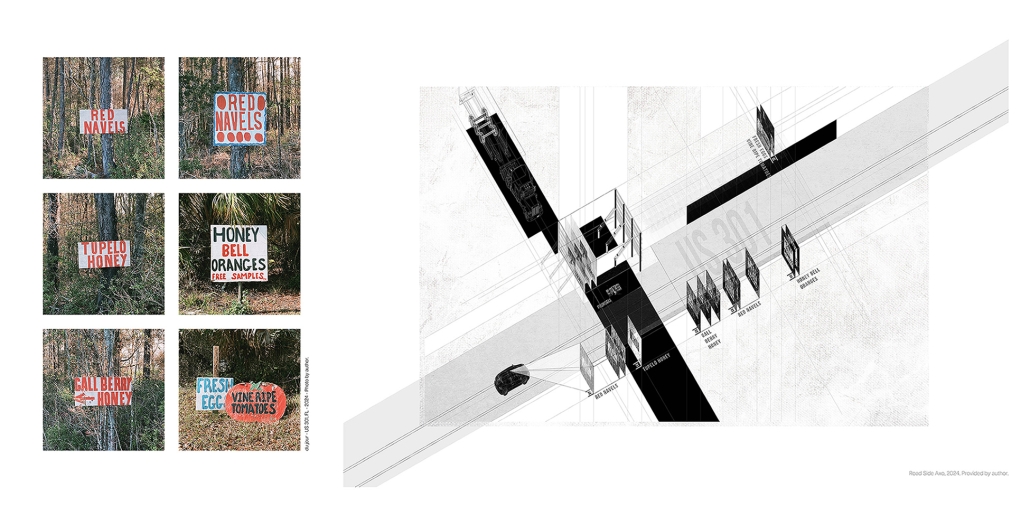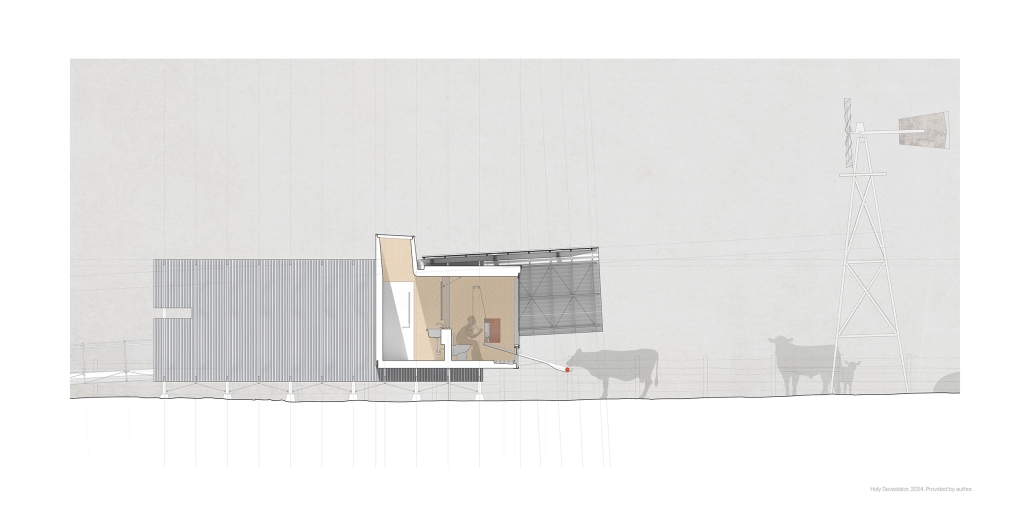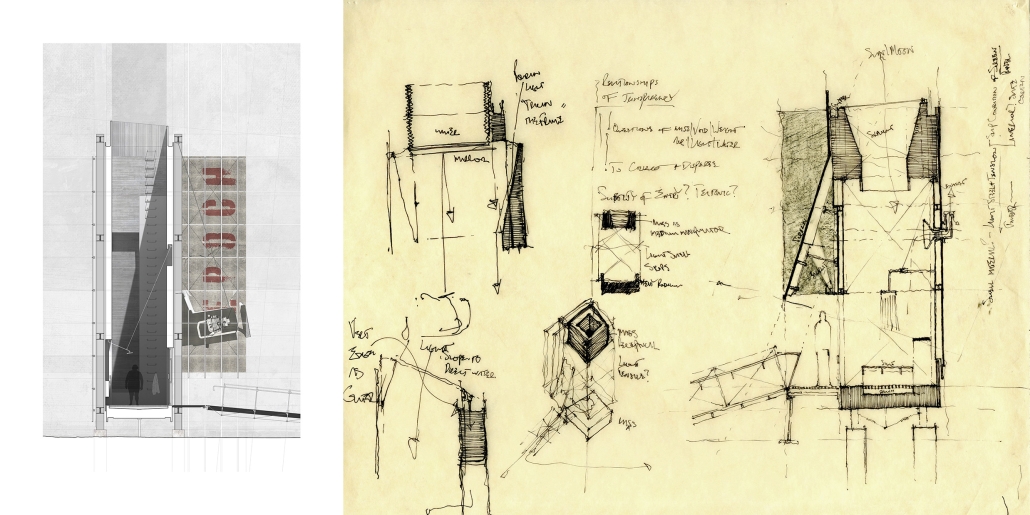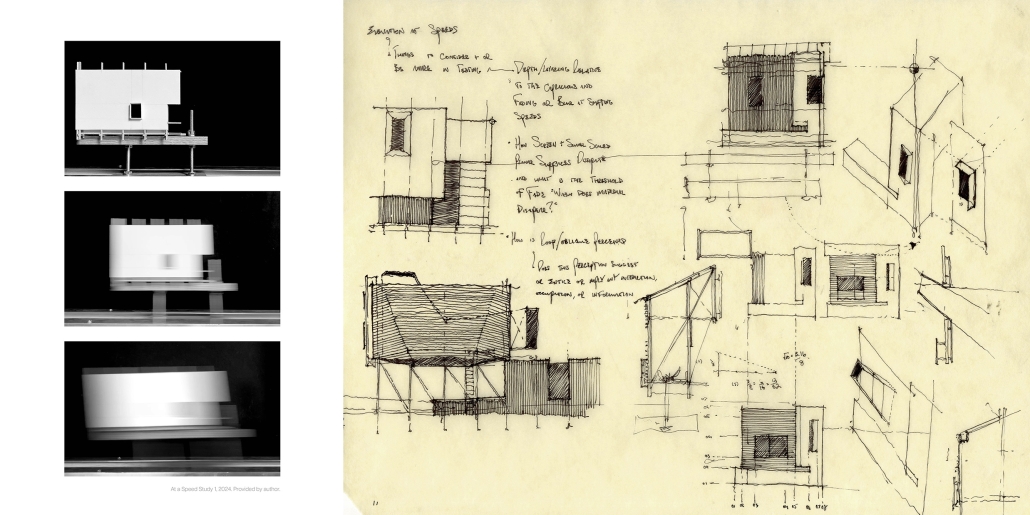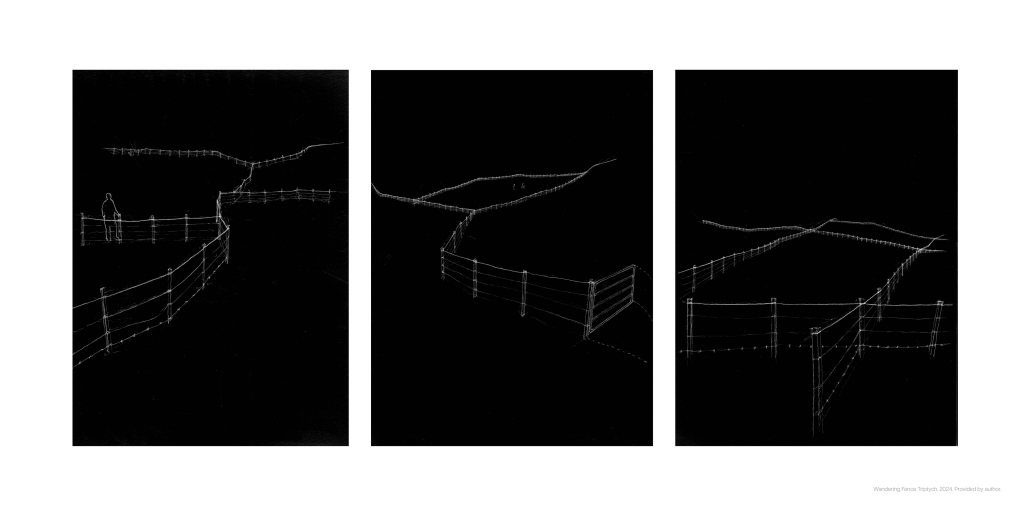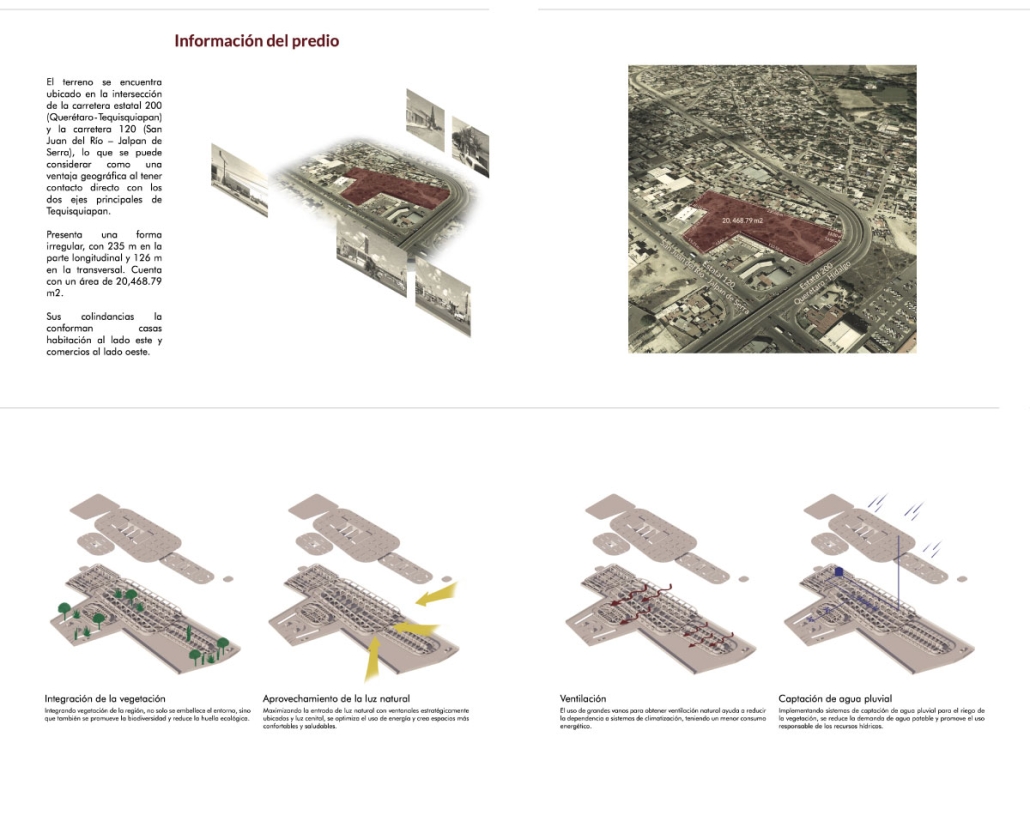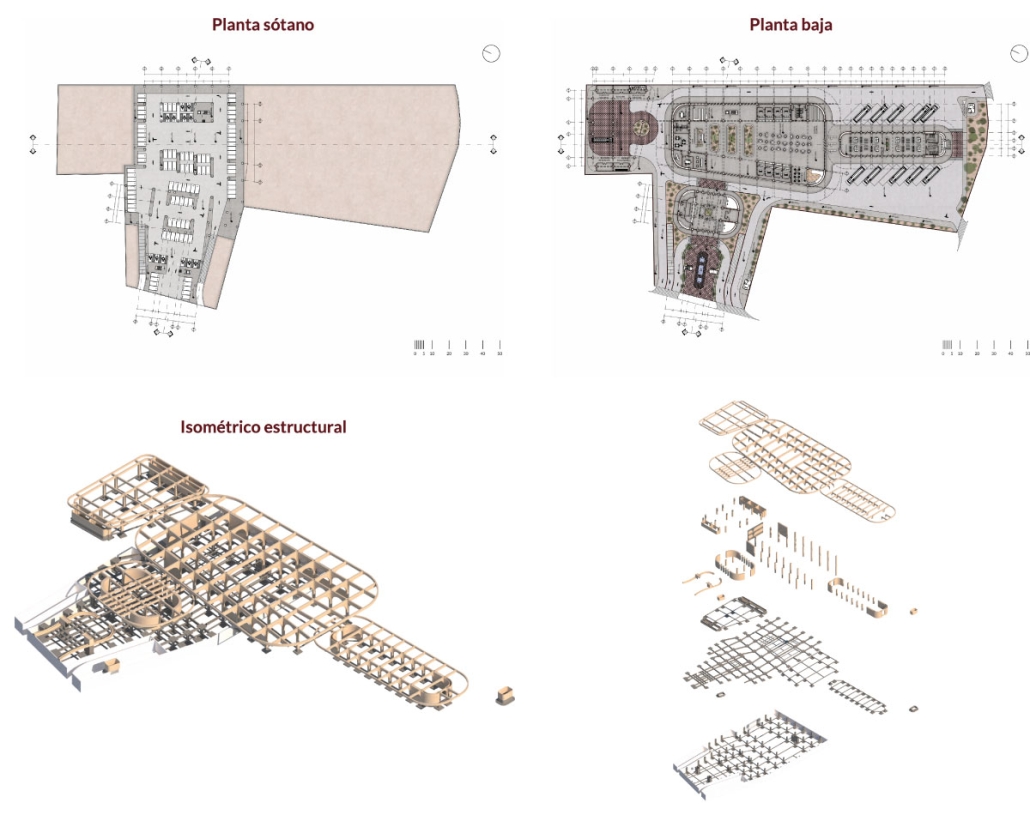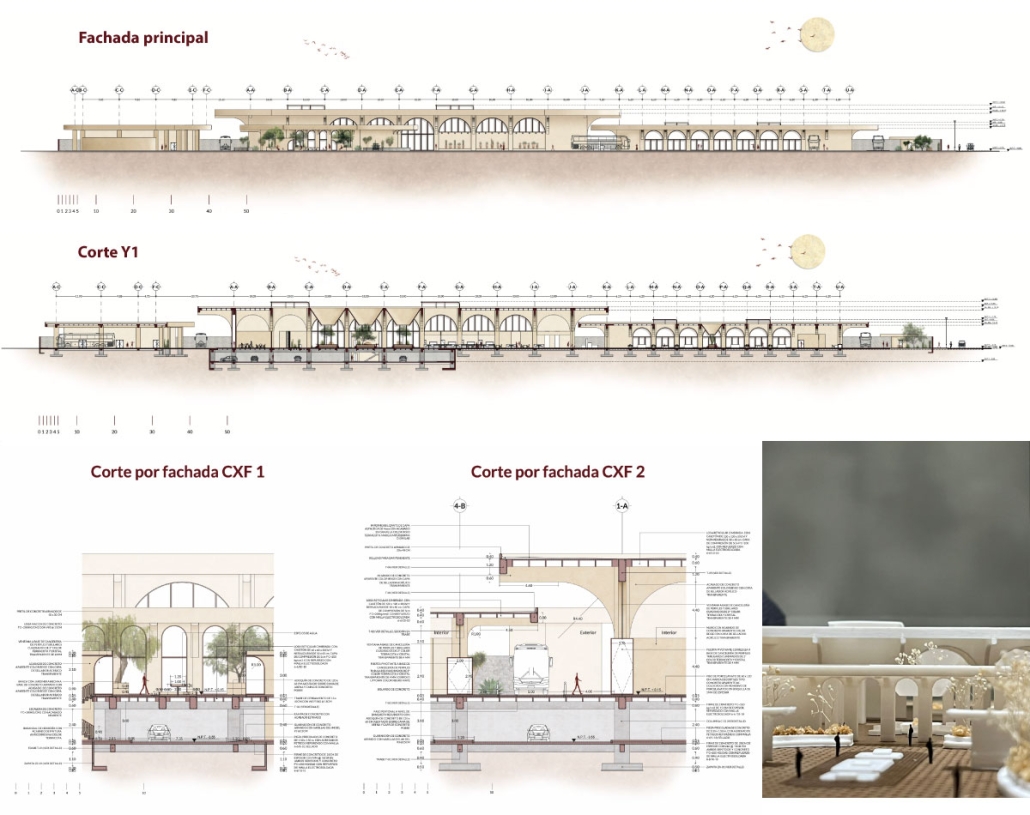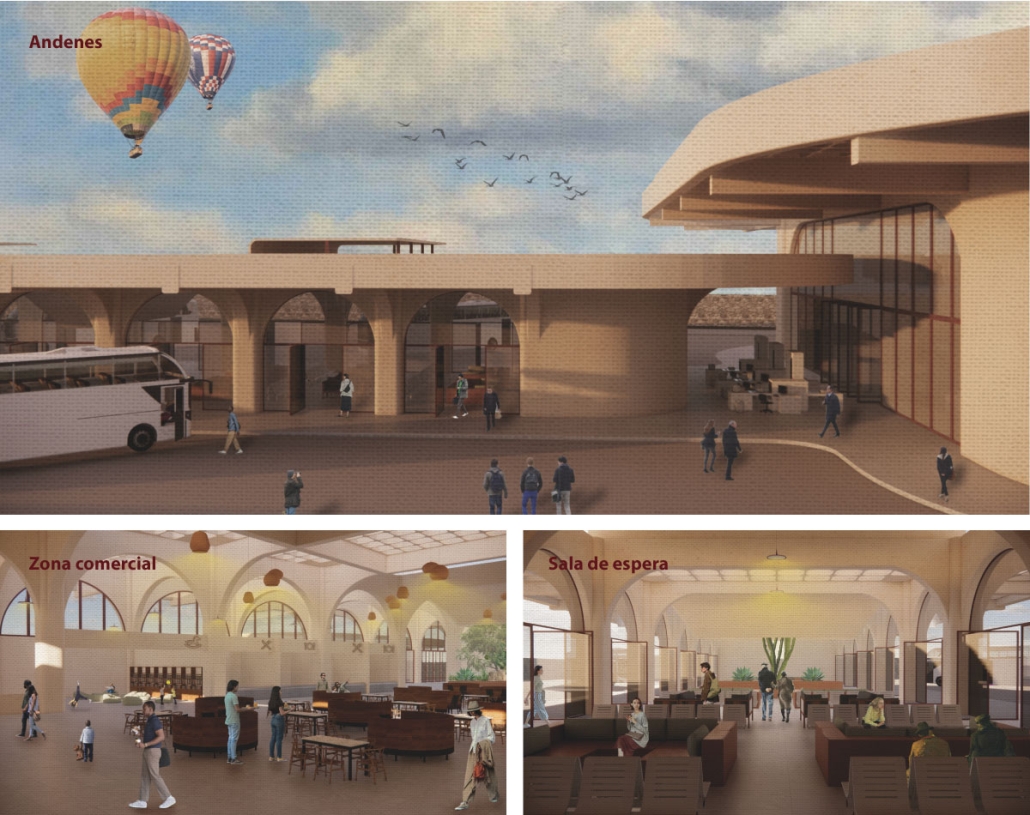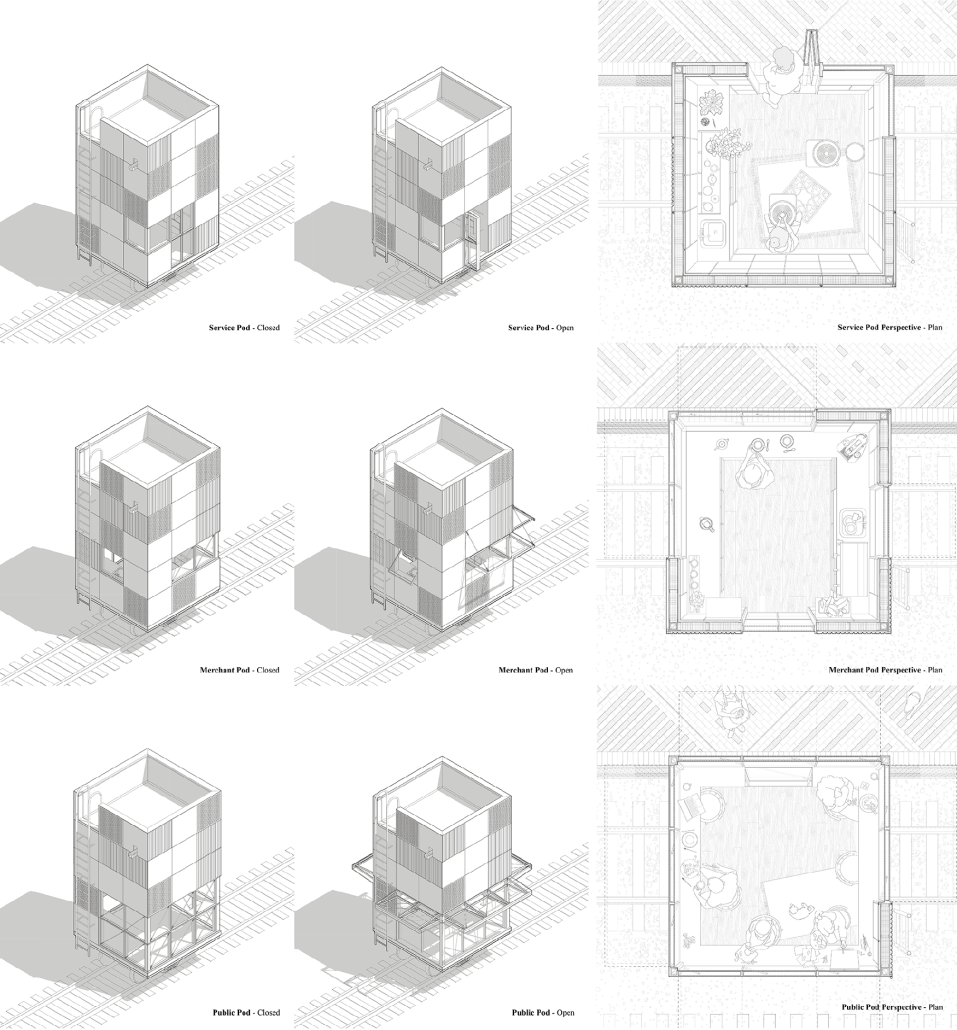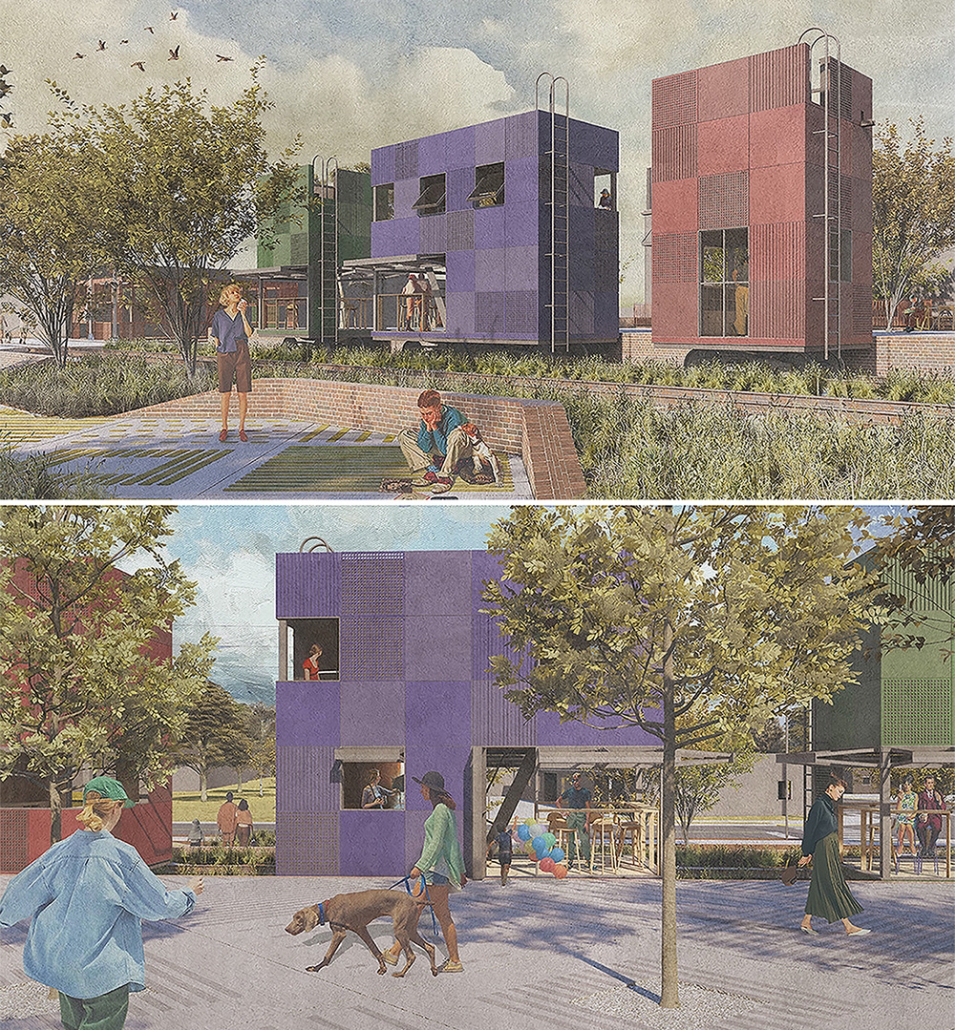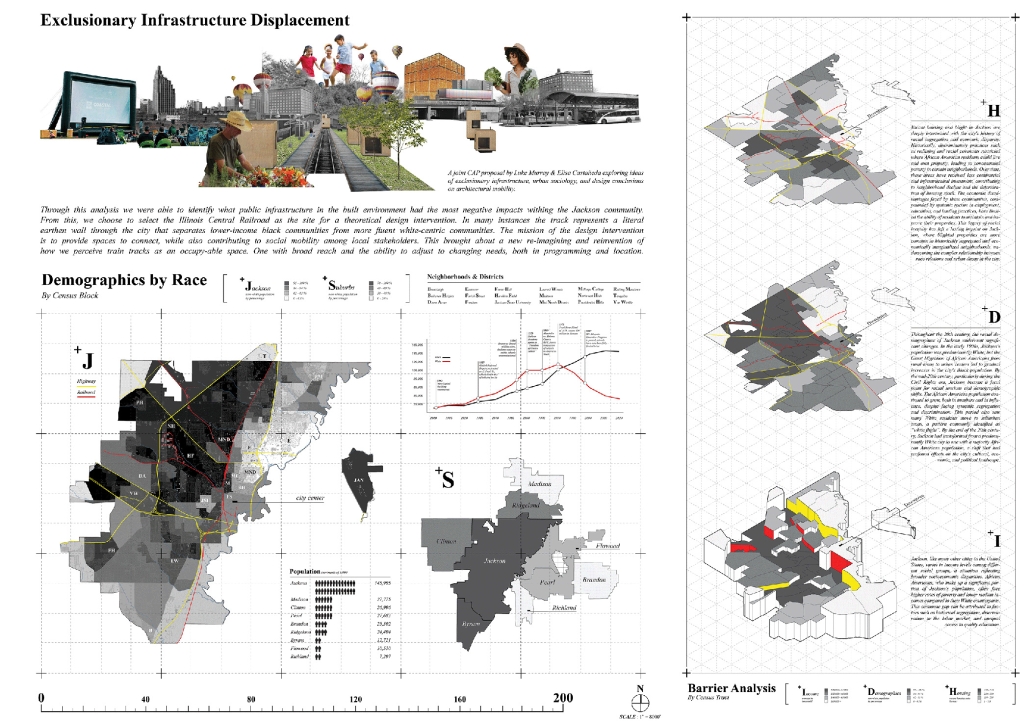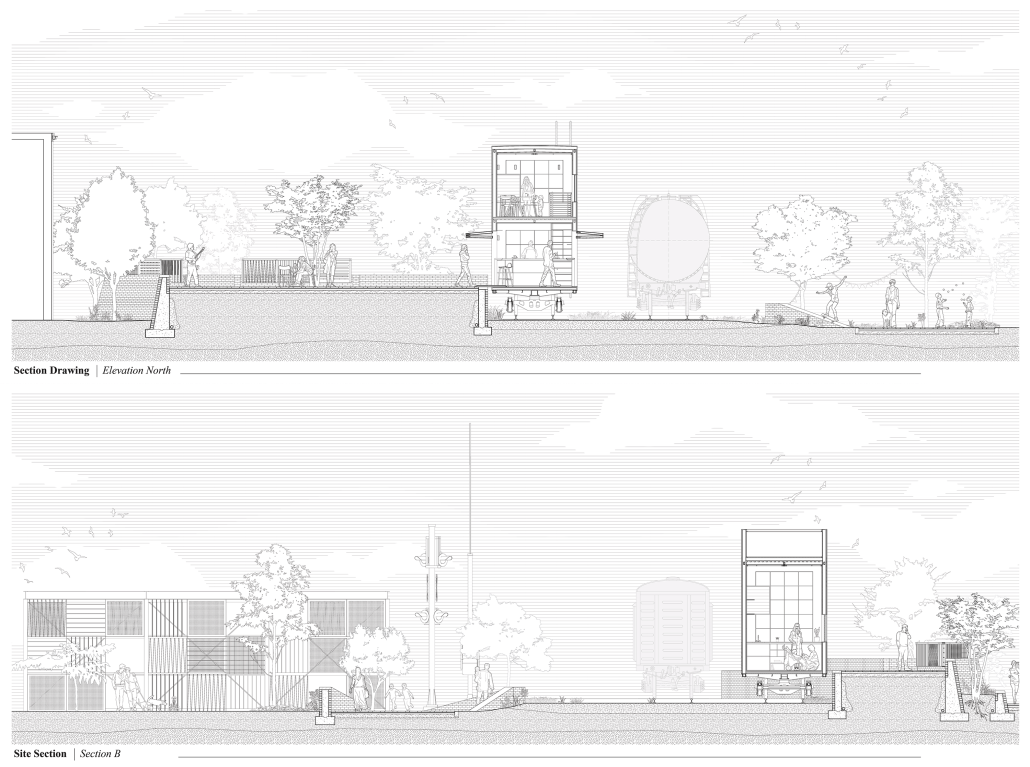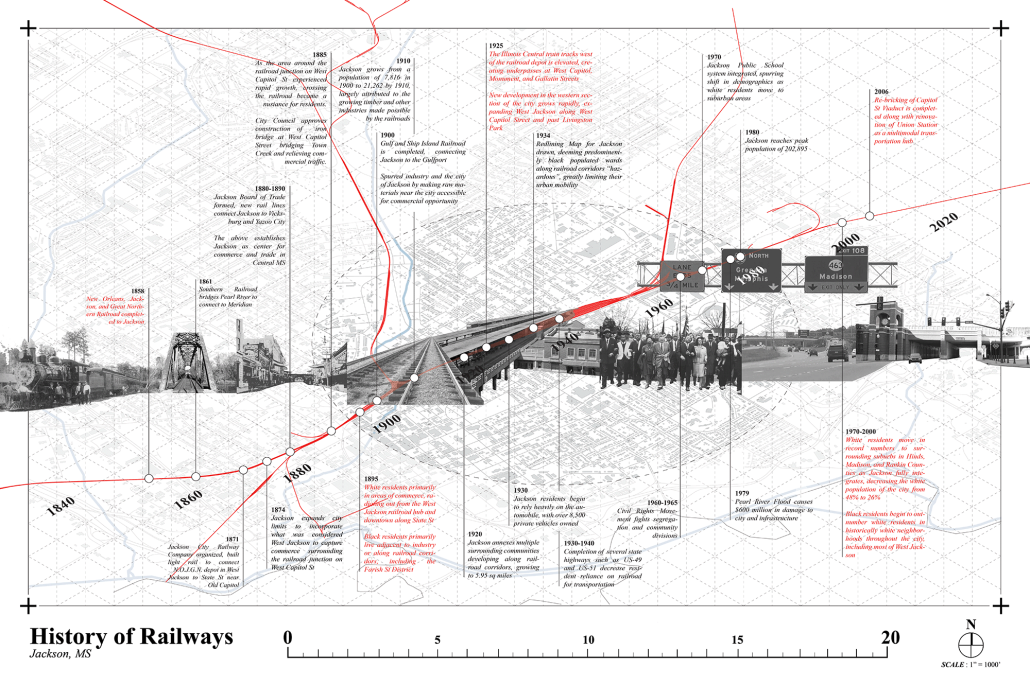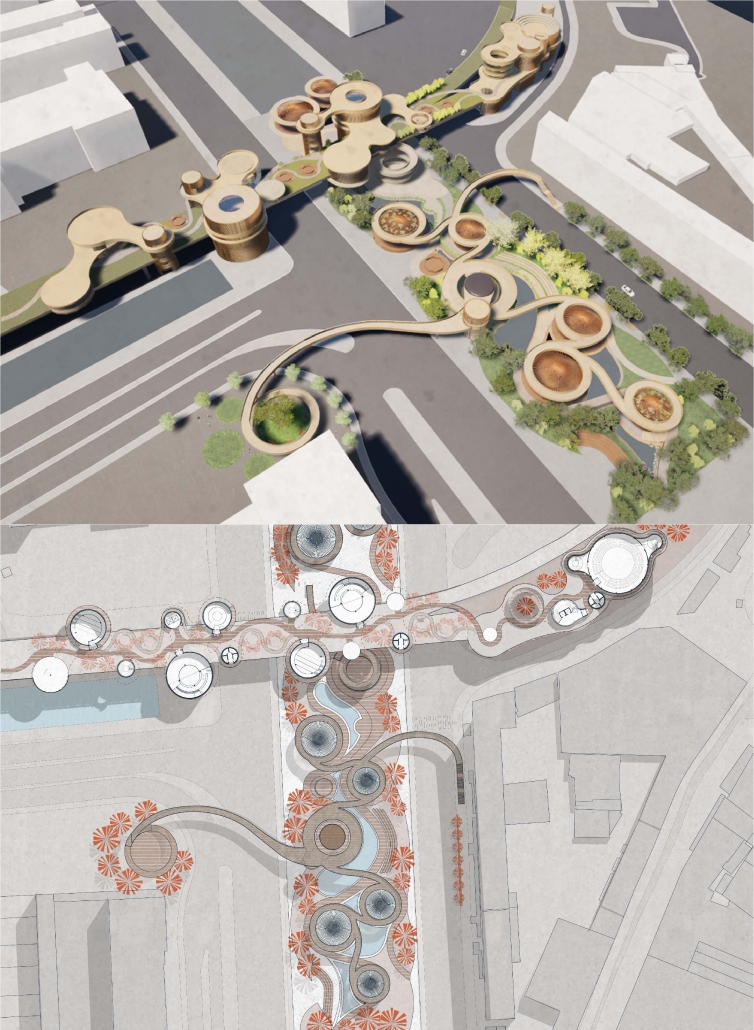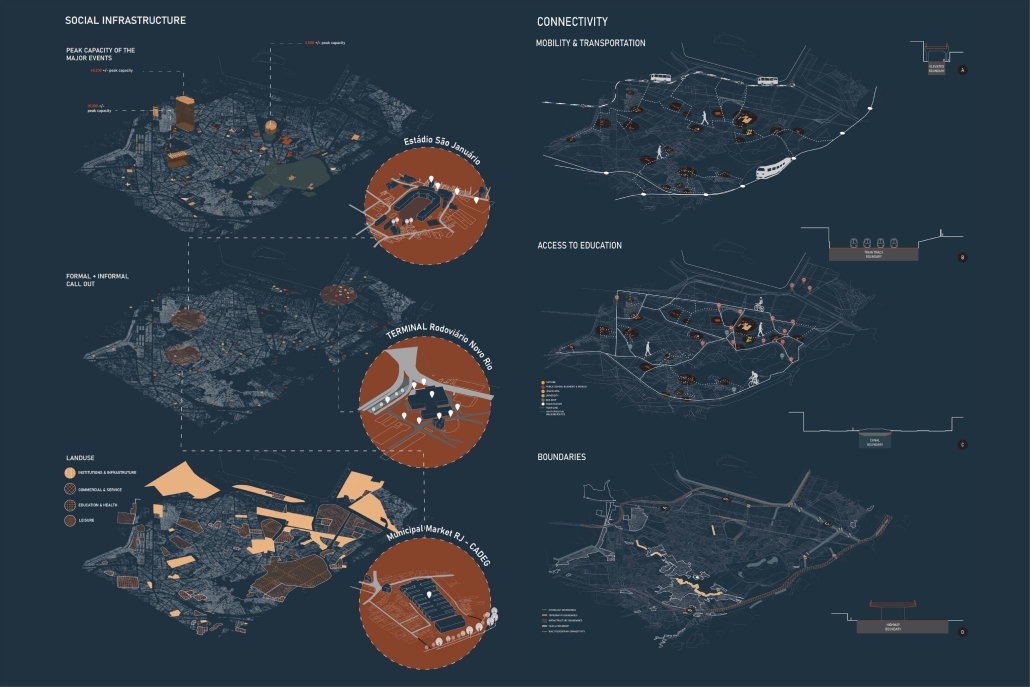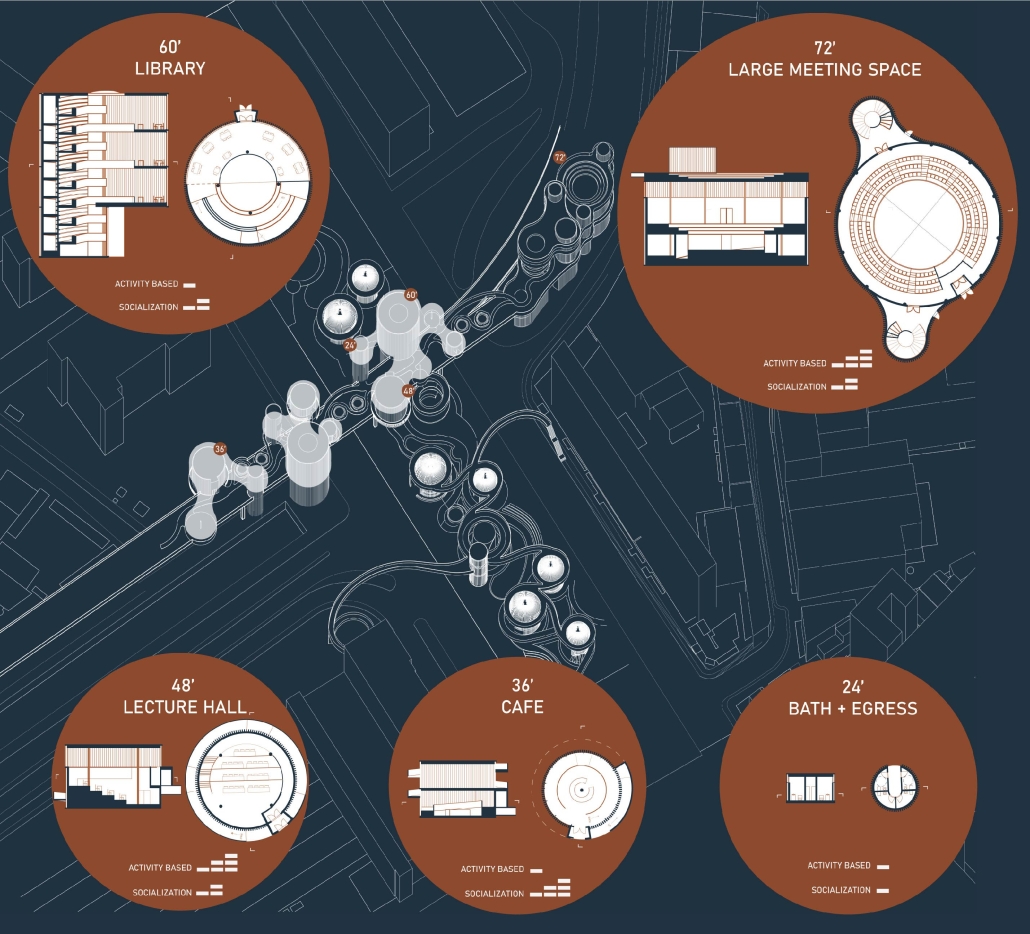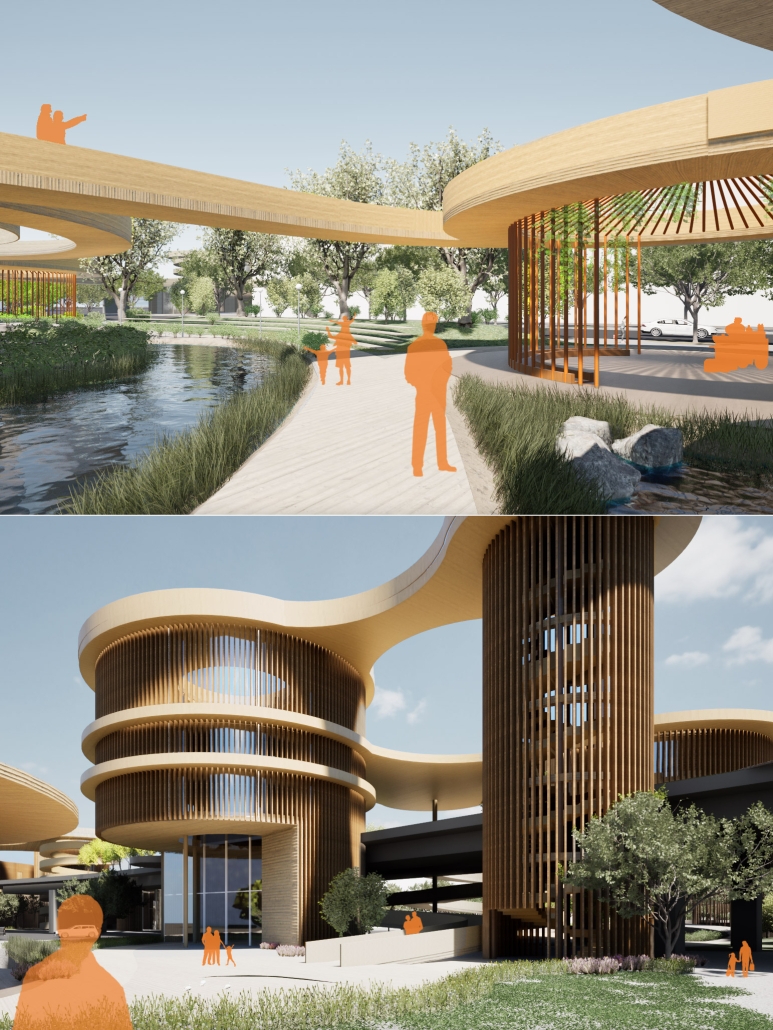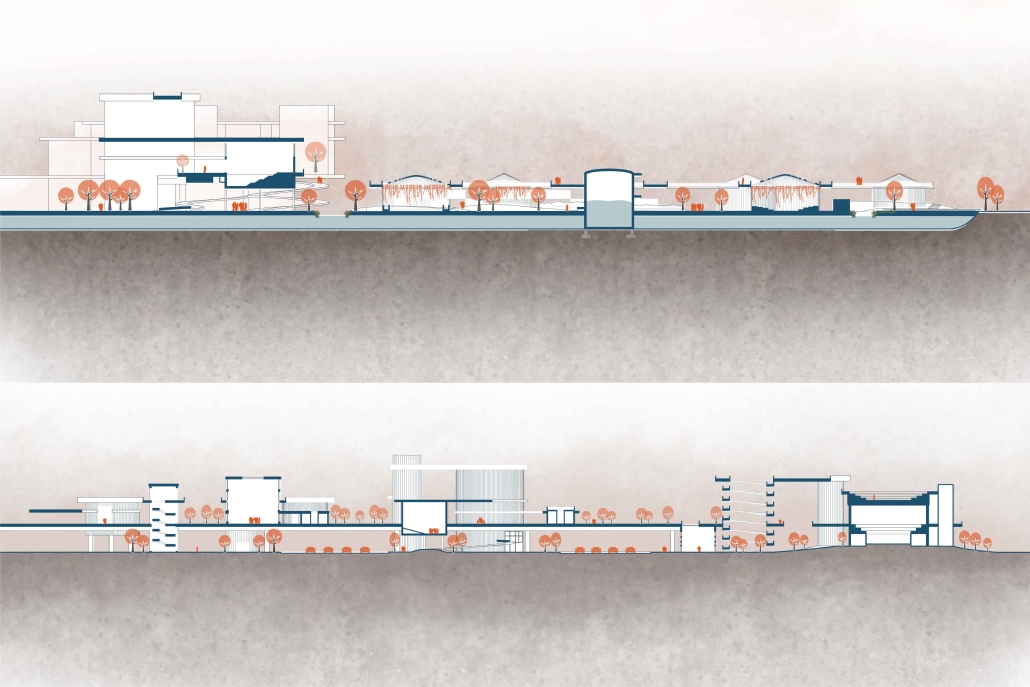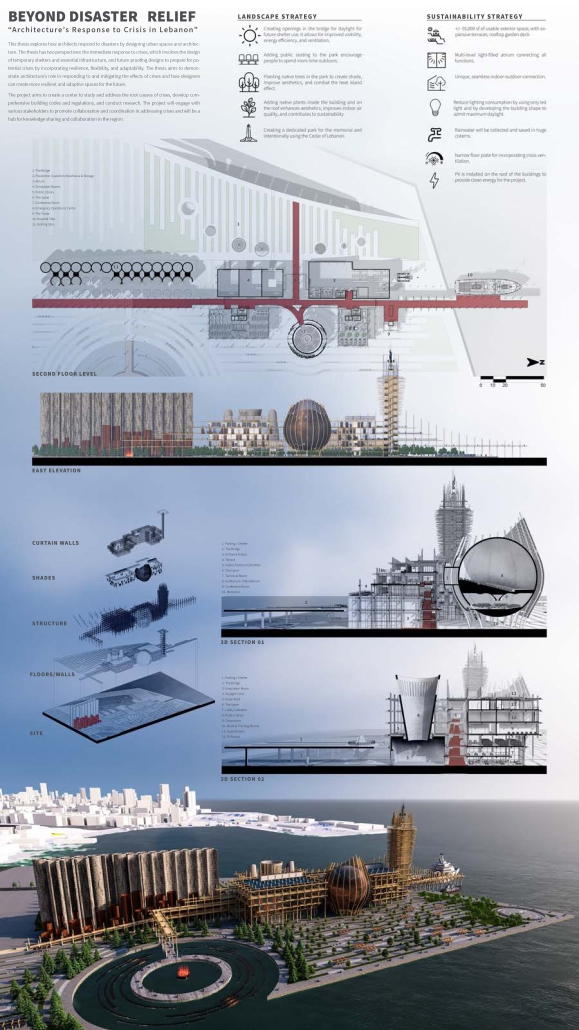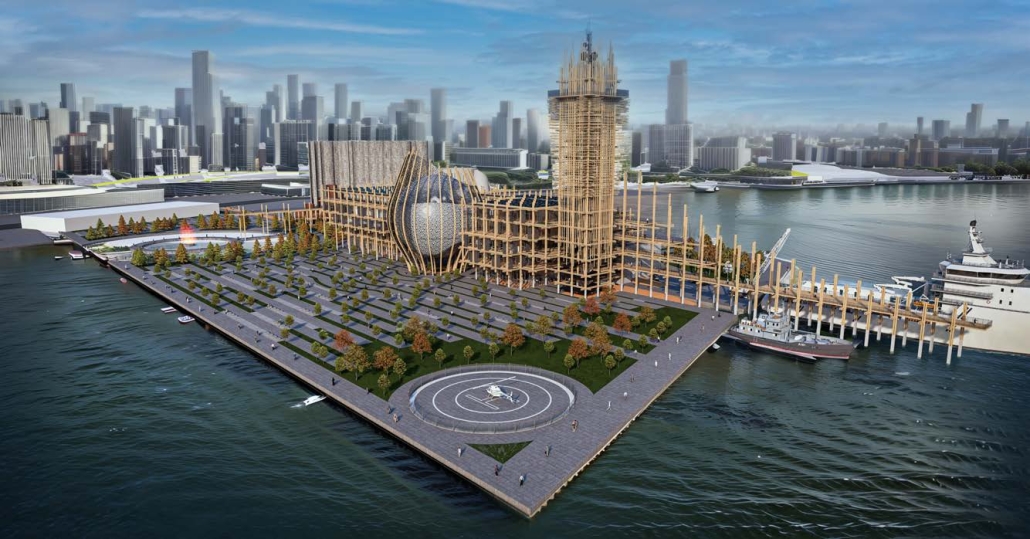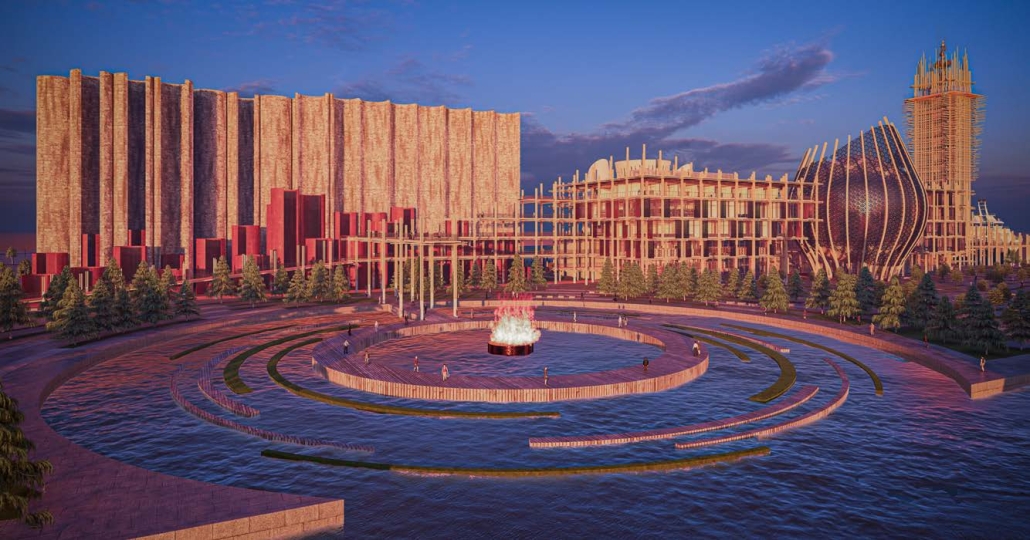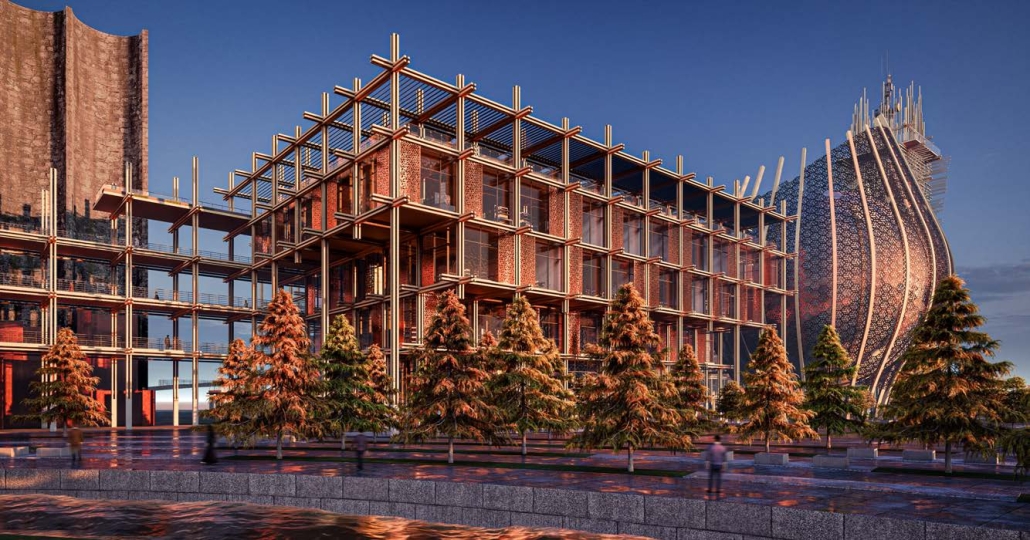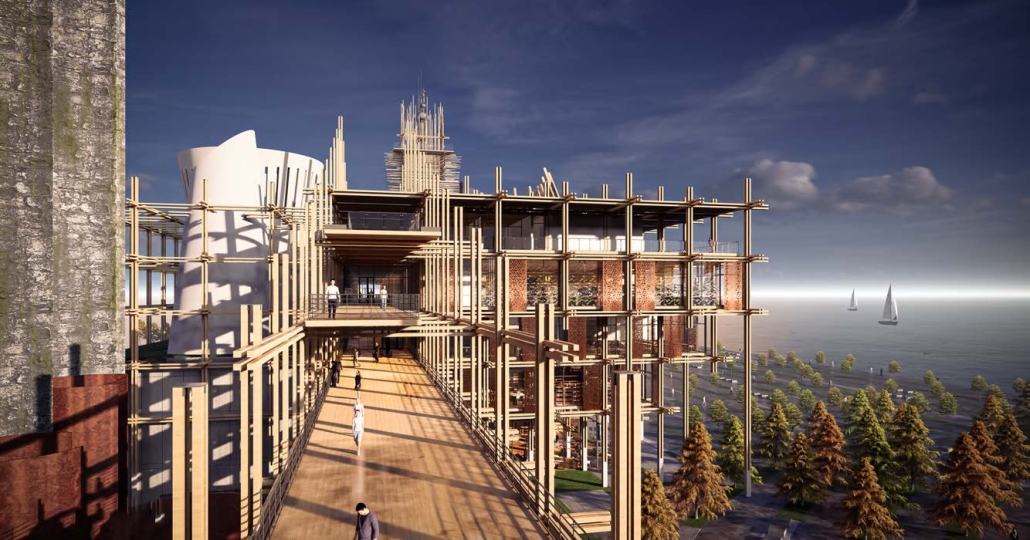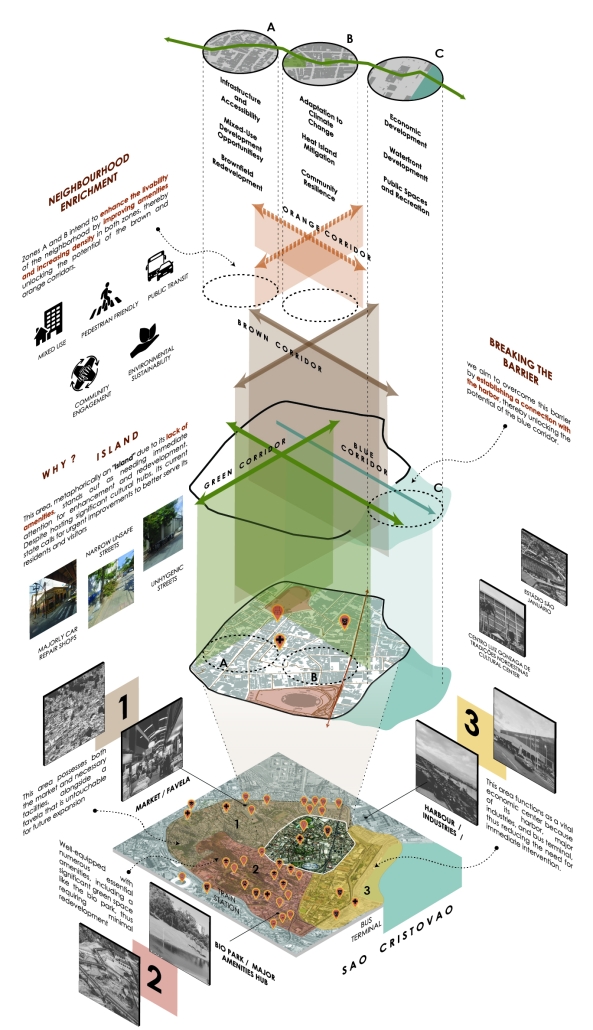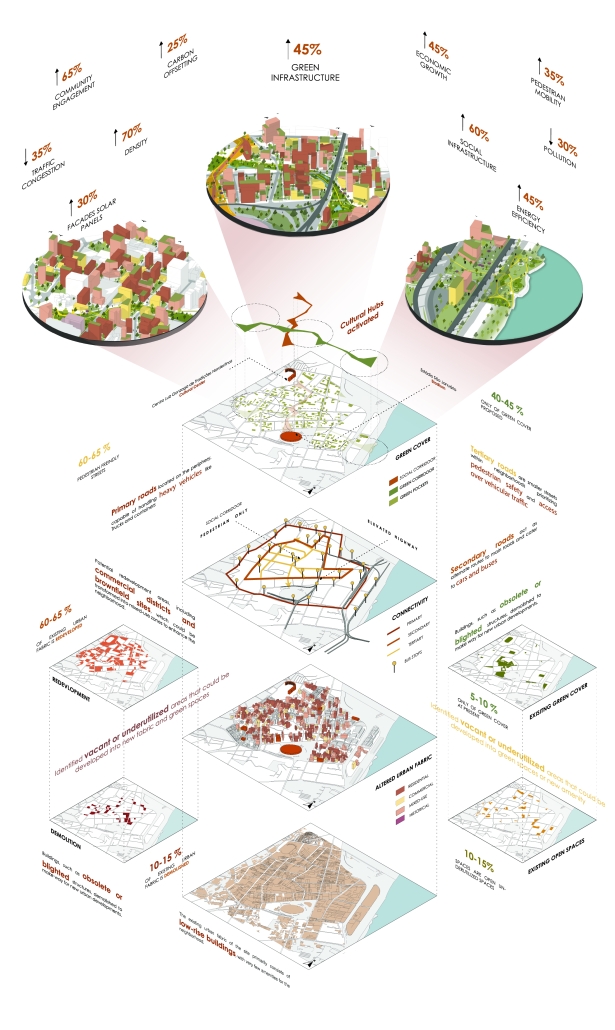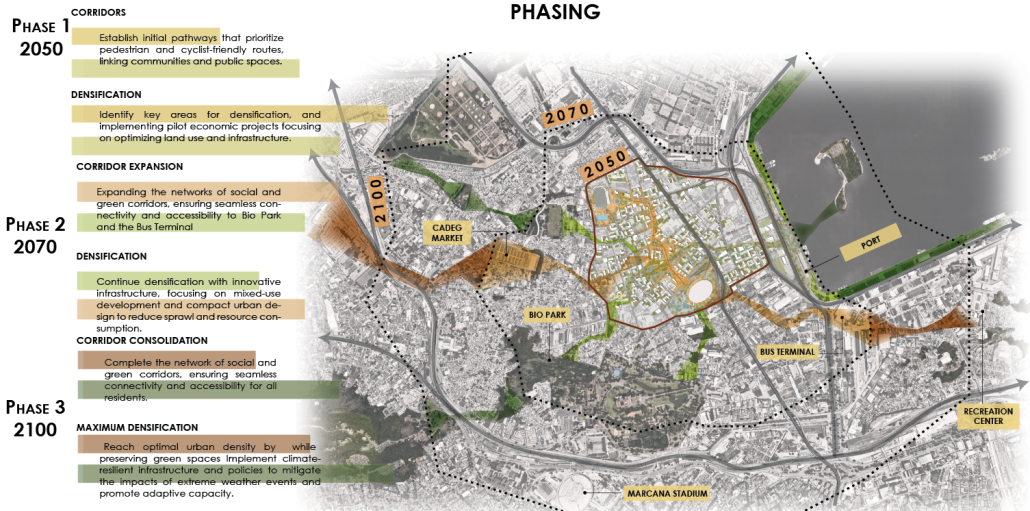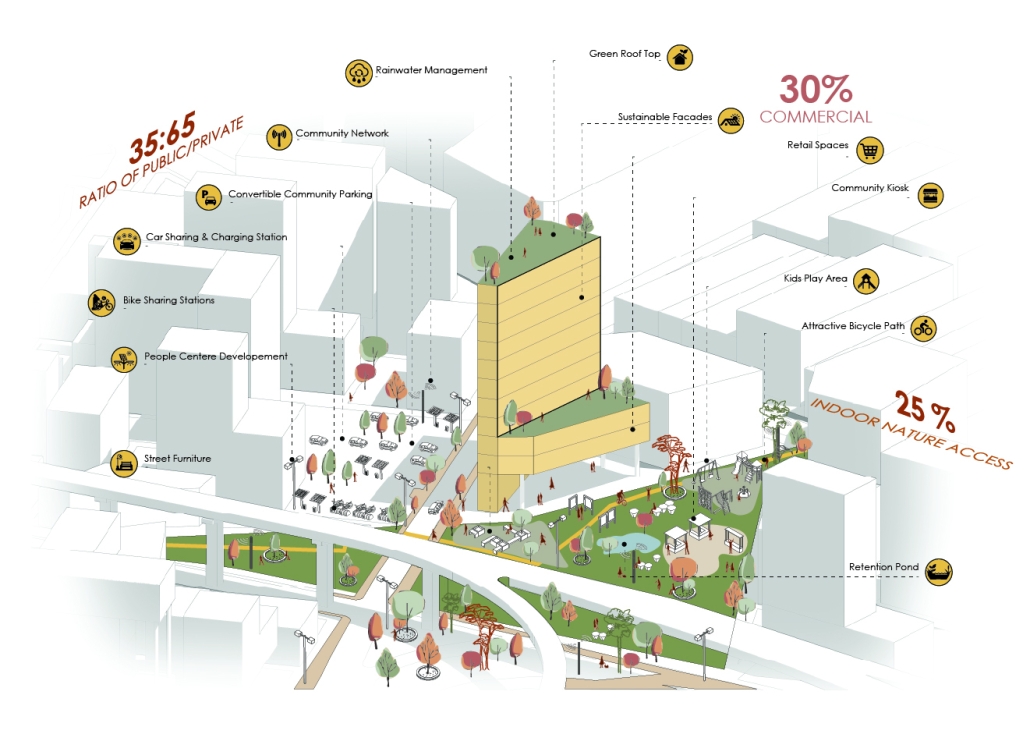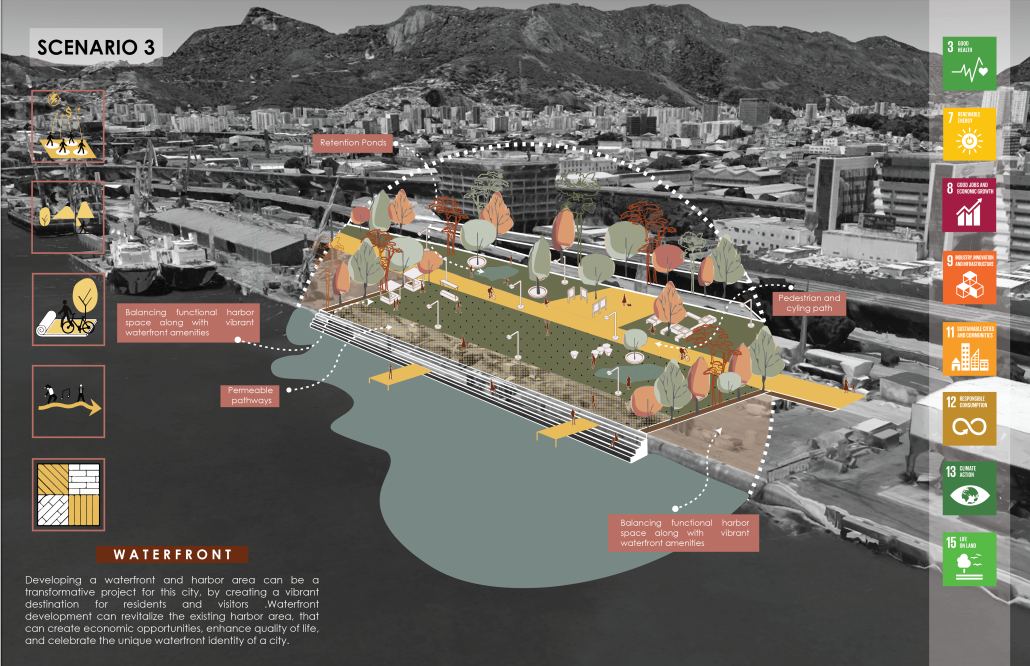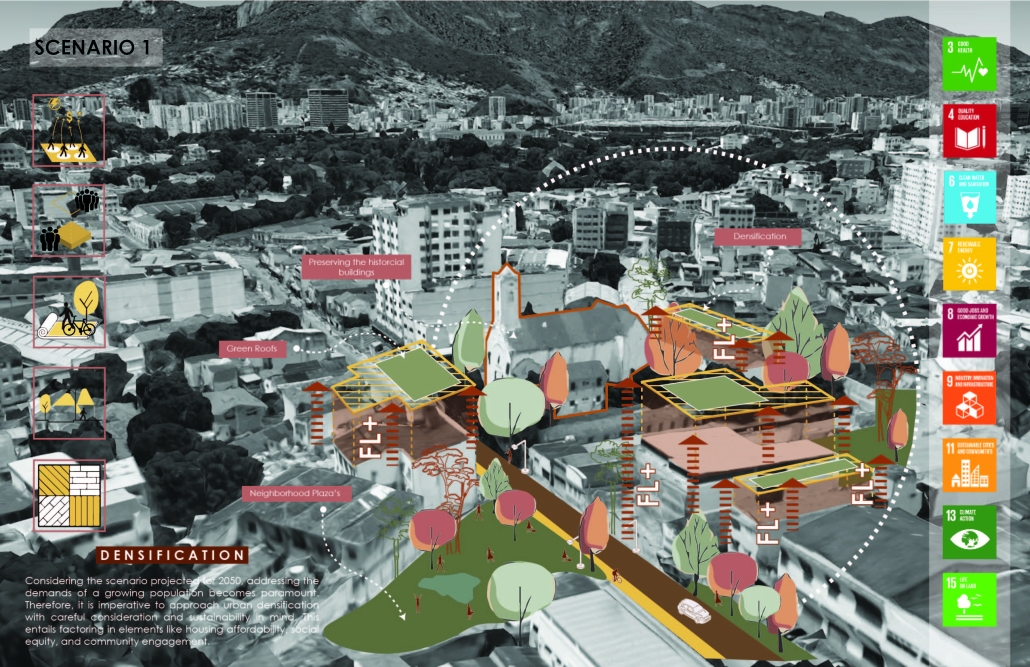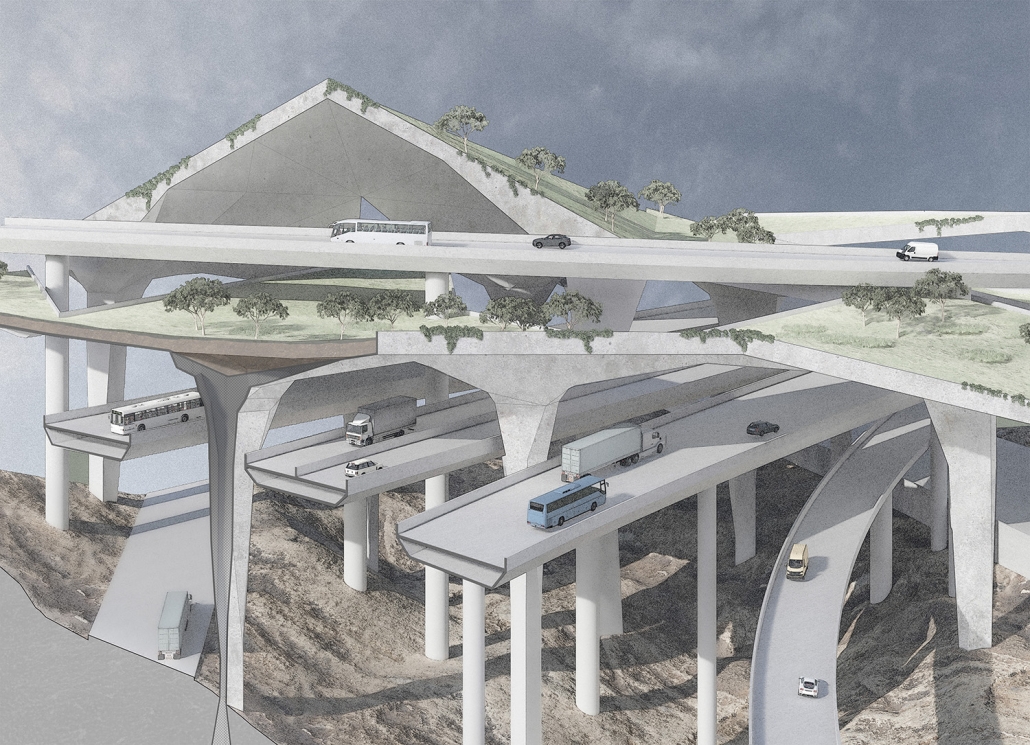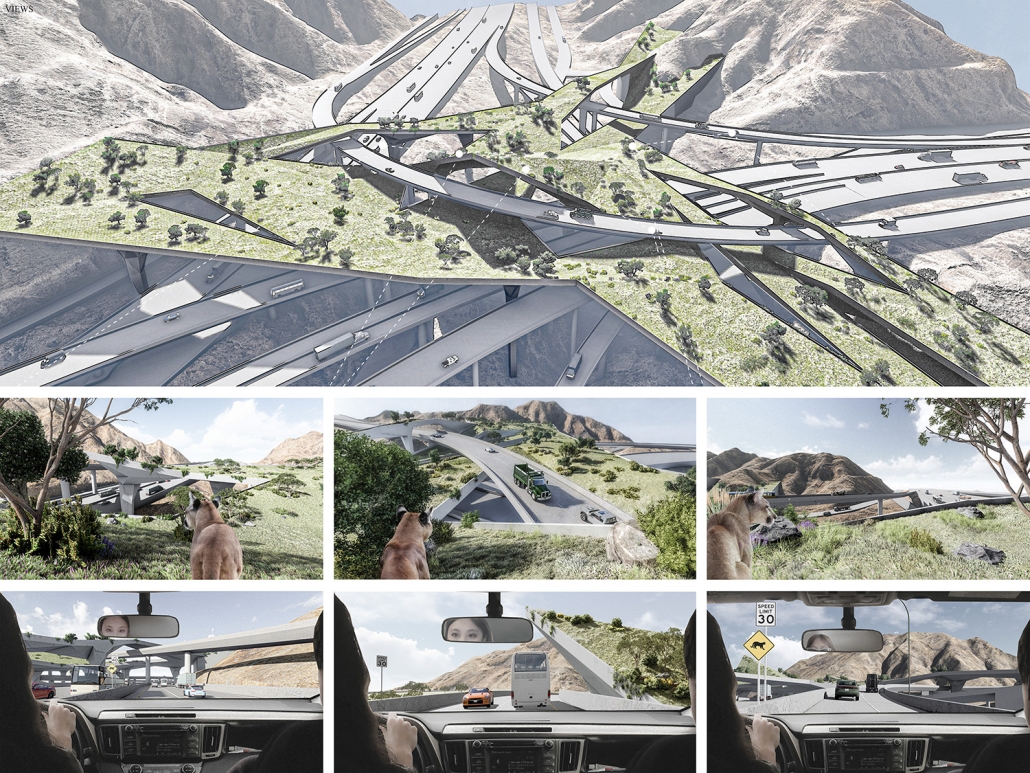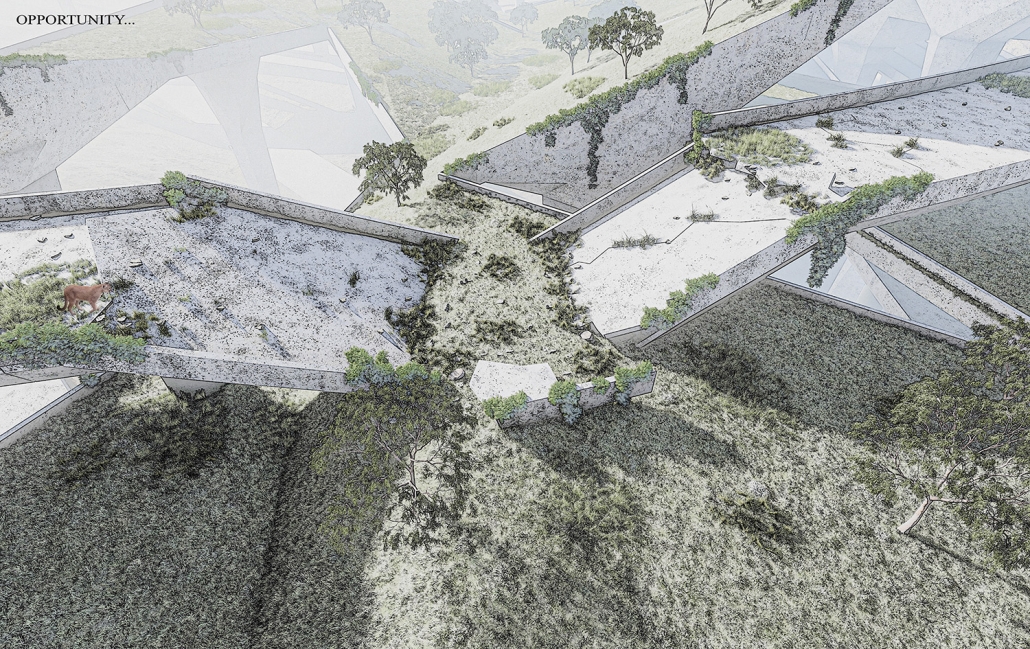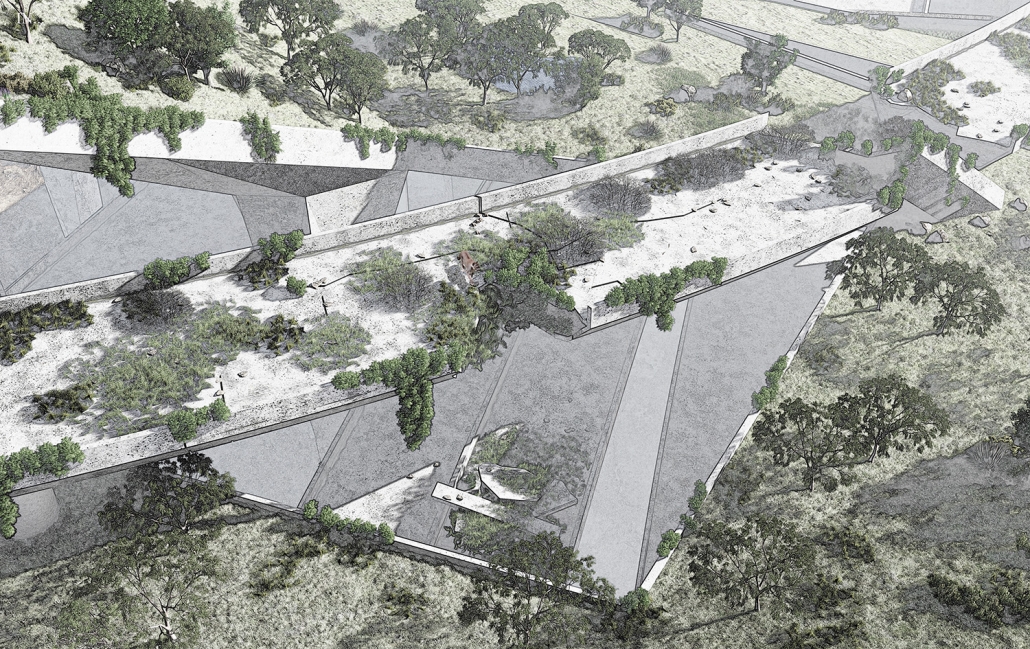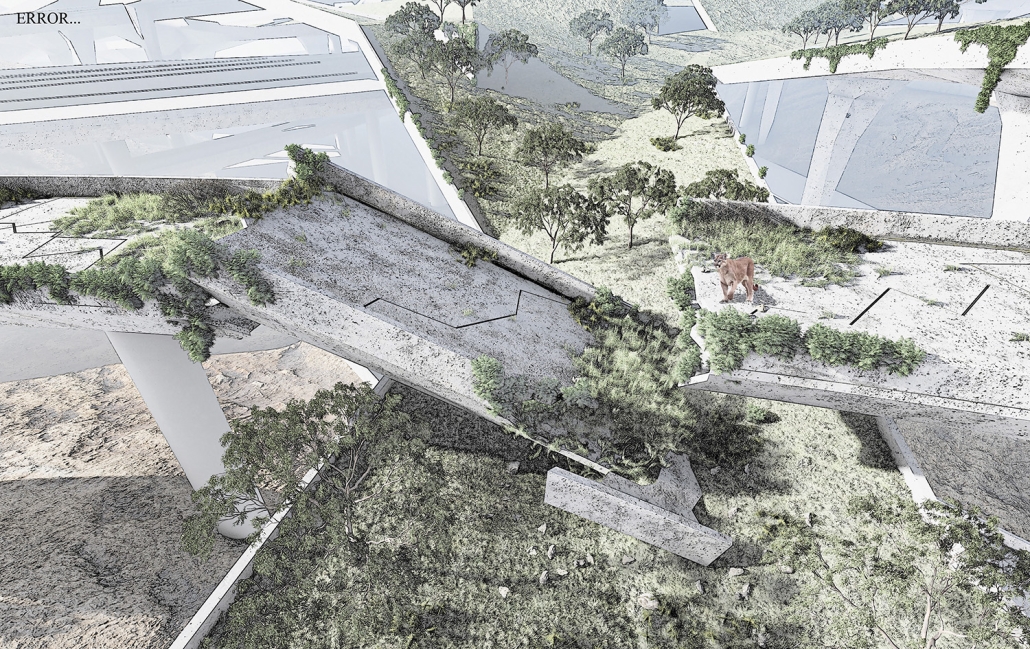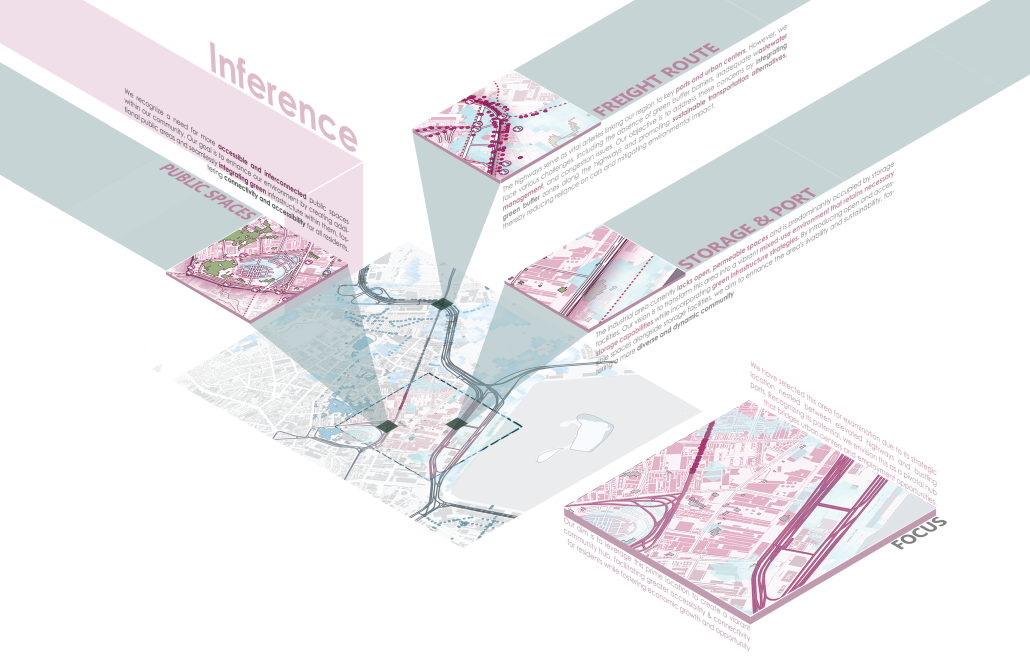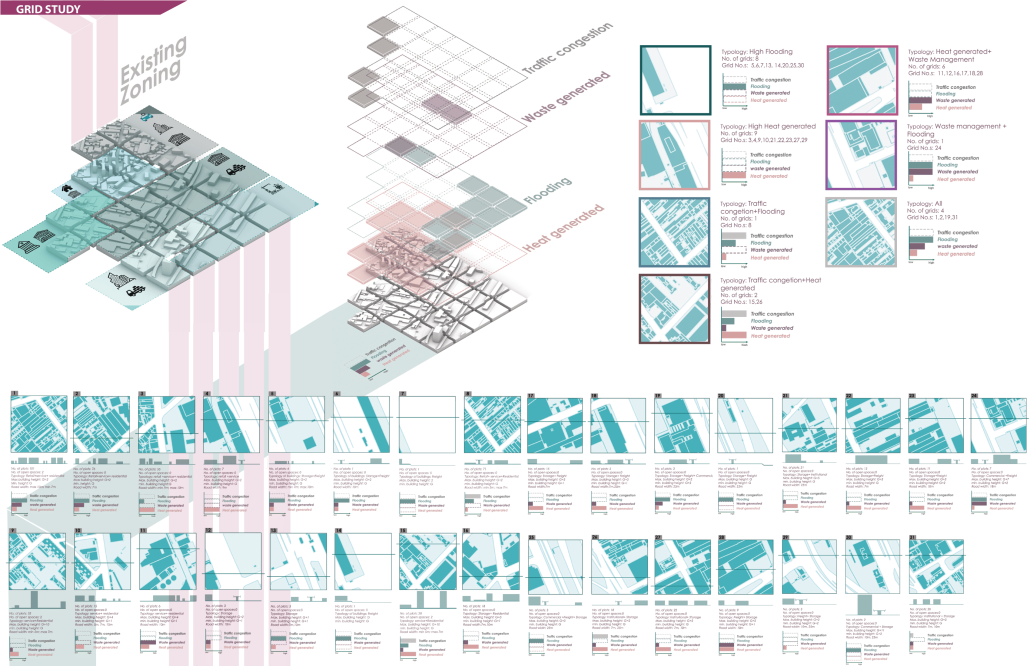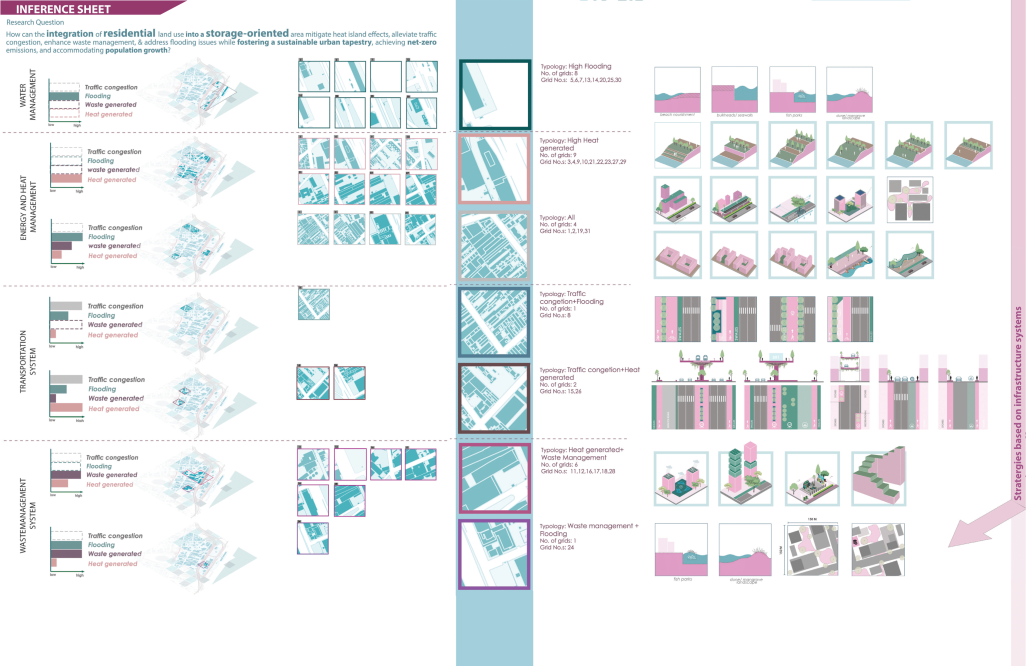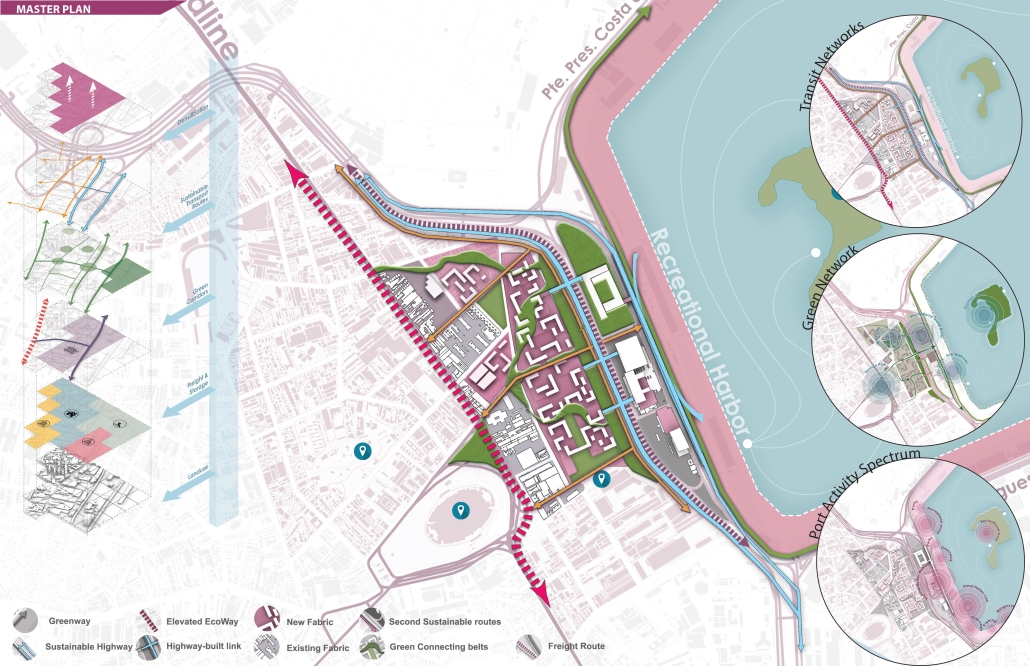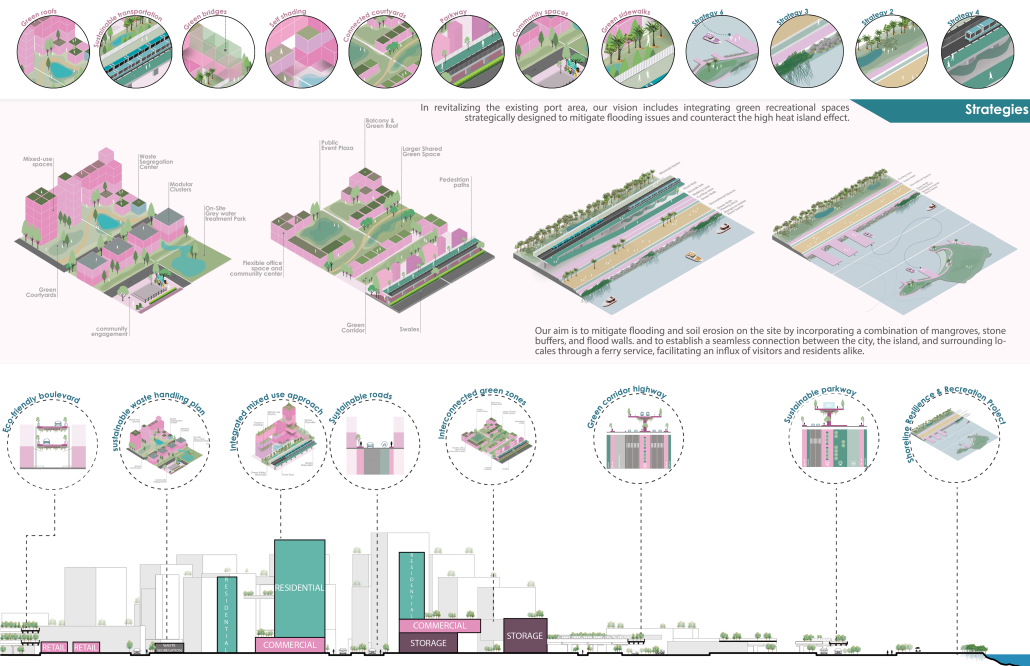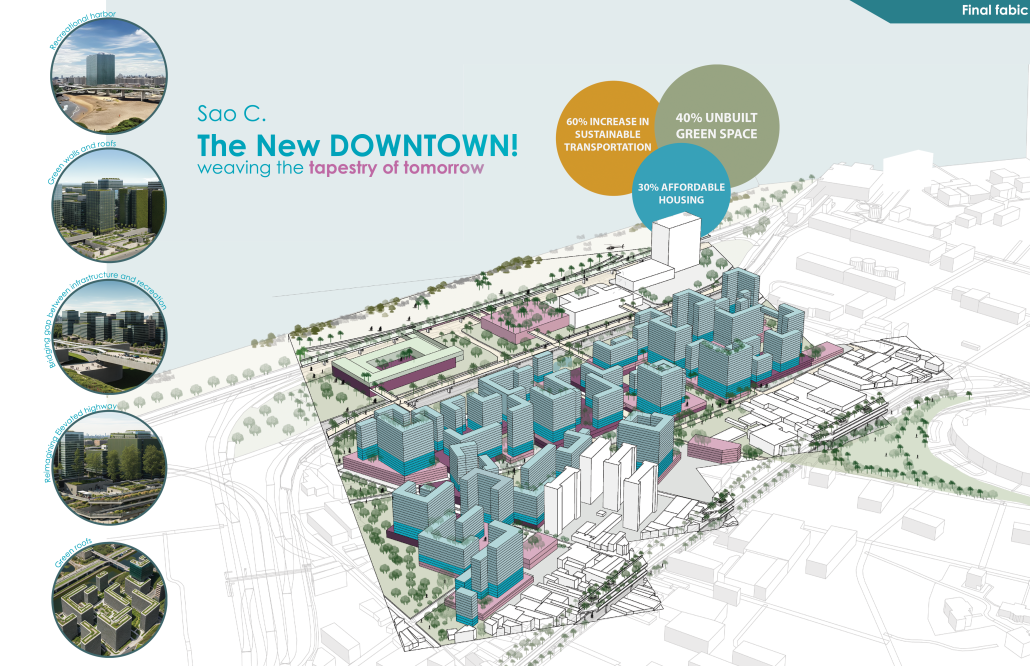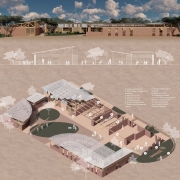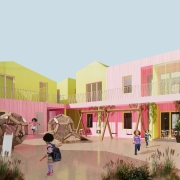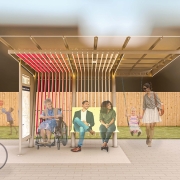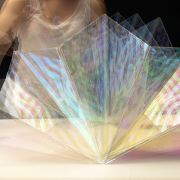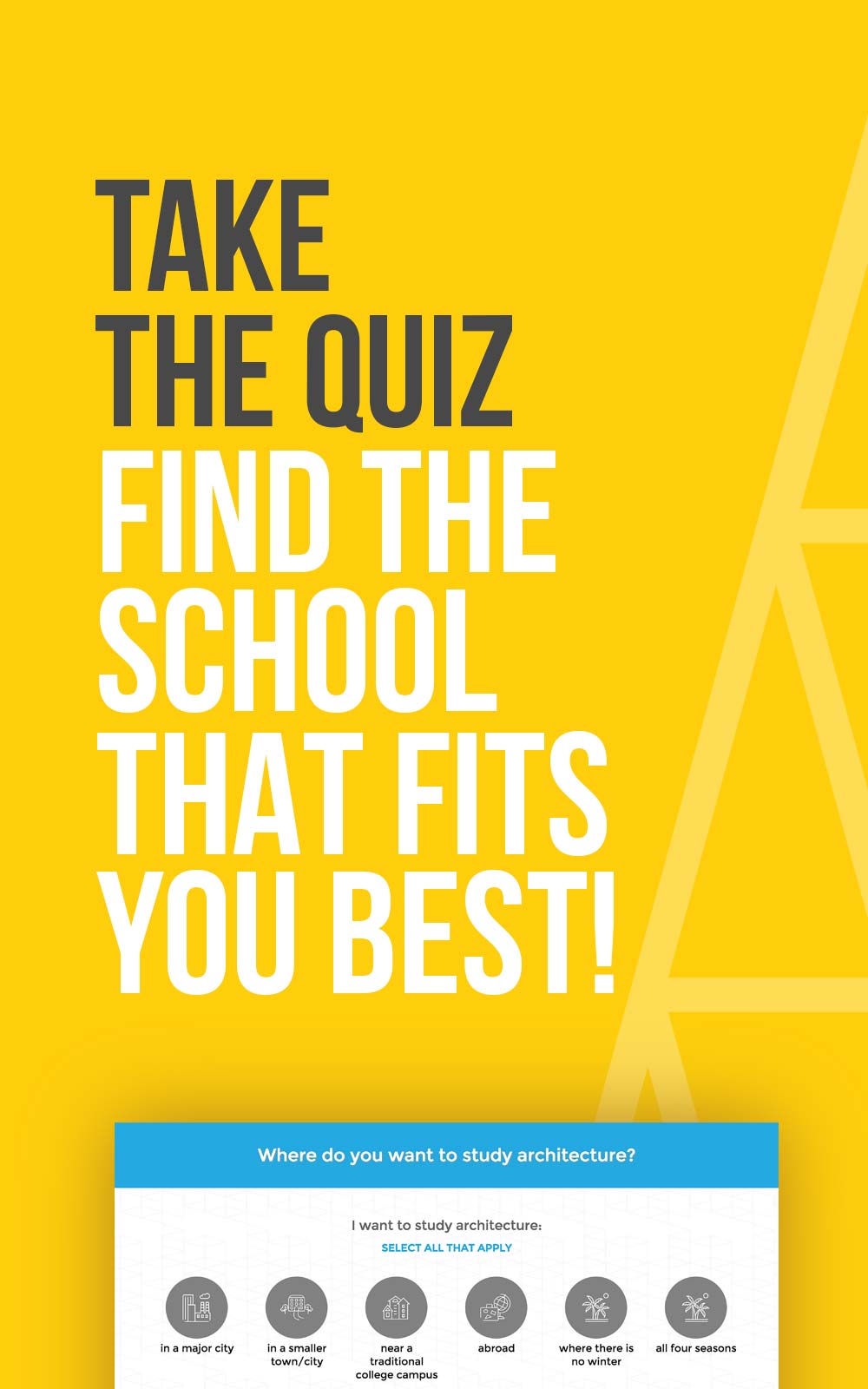2024 Study Architecture Student Showcase - Part IV
Infrastructure is the central theme covered in Part IV of the 2024 Study Architecture Student Showcase. Defined as “the facilities and systems that serve a community,” infrastructure can range from public transportation to roadways.
Today’s featured projects look at existing infrastructure and use design solutions to improve conditions. Examples include creating opportunities for connection between surrounding areas, reimaging exclusionary foundations to support upward mobility, developing comprehensive building codes, and promoting sustainability.
Suburbia As the Anti-Society: Why We Need a Suburban Architectural Rebellion by Megan Kaminski, M. Arch ‘24
Lawrence Technological University | Advisor: Scott Shall
There needs to be a Suburban Rebellion in architecture. Suburbs were originally built for a white middle class and continue to be built for a white middle class, even as suburbs begin to change and evolve socioeconomically. The conditions of which are a prevailing continuation of a dependency on automobiles, zoning, and infrastructure that becomes dangerous limitations as the flow of suburban sprawl moves income and investment farther and farther away, causing an equal sprawl of suburban decay in its wake.
Existing suburbs should be reimagined by reusing decaying or underused conditions by the community, in spite of harmful regulations that have been institutionalized since the 1950s, to rewrite them.
To investigate this, I propose to design a methodology for how future suburbs can be designed by people/the community as well as detailing how existing conditions can be reused in order to achieve this.
Instagram: @scott_shall
Post-Infrastructure: Structure as Site by Hilal Kobrosly, B. Arch ’24
American University of Beirut | Advisors: Carla Aramouny & Sinan Hassan
The concept behind this project is an exploration of how infrastructure, in this case, the columns of the Mdayrej bridge, can undergo a profound transformation, transcending their utilitarian purpose to become integral elements in a new architectural narrative. By interweaving a performance hall and a hotel into the existing columns, this endeavor challenges conventional notions of these structures as purely functional, highlighting their potential as generators of space and meaning.
The project’s design engages with the history of architectural evolution, drawing inspiration from the Cordoba Mosque’s expansion stages. Much like how the mosque’s structure evolved over time while maintaining its essence, this project seeks to evolve the bridge’s columns, blurring the lines between pre-existing and newly constructed elements. This approach introduces a sense of continuity and harmony to the site, where the boundaries between old and new become indistinct.
As one enters the parking area, the experience unfolds progressively. The scale shift from the vast field of columns to the more confined performance hall is reminiscent of a journey through architectural time and space. It is as if one is moving through layers of history and design, gradually immersing themselves in the evolving narrative of the project.
In the context of the performance hall, the design draws inspiration from ancient Greek theaters, where integration with the natural landscape was paramount. Here, the topography lines of the site plan effortlessly lead to a niche beneath the eastern columns of the bridge, forming a natural amphitheater.
The roof overhead serves as the only enclosure needed, allowing the audience to connect intimately with both the landscape and the columns. In this setting, the columns cease to be mere structural elements; they become performers themselves, adding a dynamic dimension to the grand hall’s ambiance.
Moving on to the hotel, it occupies a floating strip, gracefully positioned above the performance hall’s roof. Along the western columns of the bridge, the project’s field condition undergoes a transformation.
The columns, now experienced at a more intimate scale, transcend their load-bearing role to become intricate surfaces. This shift in perspective challenges preconceived notions about the relationship between structure and space, highlighting how architecture can breathe new life into utilitarian elements.
Instagram: @ard_aub
Turnpike Beef by Ray Wincko, M. Arch ‘24
University of Florida | Advisors: Charlie Hailey & Bradley Walters
Turnpike Beef is a design project that synthesizes the inherent relationships amongst underlying infrastructural systems, the subliminal qualities of the banal, and a bucolic Floridian landscape. Florida is notorious for fantastical manufactured environments like the neon nightmares of Miami or the fabricated magical kingdoms of Orlando. Turnpike Beef suggests that the systems of infrastructure that stitch these urban centers hold a more accurate perspective of what this landscape beholds. Arguably the most overlooked component of infrastructure that, in its absence and introduction, has contributed to the development of Florida is the fence.
Through the analysis and invigoration of the fence, Turnpike Beef aims to envision how “fence” as an architectural tool can catalyze and shift the manner in which citizens perceive and interact with infrastructure, banal space, and the in-between of the Florida landscape. Once the idea of the fence surpasses its normally understood role of line and boundary, it acquires a greater set of roles as a spatial mediator, raconteur, and witness to the environment. The fence is most often interacted with while traversing between destinations at high speeds which demands a regional scale of response. Along with a regional response, a more impactful aspect of infrastructural interaction is that in a time of intimate and reflective pause or rather, rest.
In search of tying narrative and conditional threads between infrastructural landscape and seemingly regular program, this study proposes a set of interventions that utilize the “fence” as a tool for synthesizing and charging spatial, political, and cultural relationships. The intervention, programmatically, is a reinterpretation of a contemporary staple of American travel, the rest stop. A generally disregarded, temporal experience along our routes, the rest stops of Florida’s state highway system are designed to operate as efficient exchanges of north and south-bound travelers with little regard for its infrastructural context or the often-enriched historical landscape that surrounds them. Through ceremonial defecation, boiled peanuts, trucker showers, and billboard propaganda, this project connects the individual with infrastructural traces and the forgotten celebration of the subsided program.
Instagram: @charlie.hailey, @r_winky
Central EJE de Movilidad Turística Tequisquiapan by Axel Josua Nogales Bernal, B. Arch ’24
Universidad Anáhuac Querétaro | Advisor: Jorge Javier
This project was born as an integral mobility strategy for the state of Querétaro, as well as from the need to connect the city of Tequisquiapan with the rest of the magical towns in the region.
The proposal is inserted in the periphery of the urban area, in order to integrate different local transports and make it easier to move around.
The building, a structural integration of uniform columns that link the large concrete roof through subtle arches, divides the public part from the private part, expanding the uses, in order to have internal plazas and open spaces and thus achieve a great amplitude for the transit and boarding of the bus users.
This project won the 2024 AIA Triangle Student Design Award.
Instagram: @axelnogales, @ajnb_arq, @arqwave, @arquitectura_anahuac
Exclusionary Infrastructure & Displacement: A Study on Architectural Mobility by Elisa Castañeda & Luke Murray, B. Arch ’24
Mississippi State University | Advisors: Jassen Callender, David Perkes, Mark Vaughan & Aaron White
Jackson, Mississippi, is a unique place, the capital of the most low-income state in the Nation, the Blackest major city in the United States per capita, and a city whose history is translated through its infrastructure and built landscape. While the implementation of policies and regulations are directly in view as forms of disenfranchisement in marginalized communities, public infrastructure, urban planning, and the built environment are not often recognized as forms of regulation. The placement of highways, railroads, walls, and more, have had profound effects on the organization of different racial demographic groups within the city of Jackson – these patterns are still pervasive today.
The above implicates exclusionary infrastructure, defined here as the placement and construction of built works that hinder accessibility between communities, resulting in systemic disinvestment and social plight.
This proposal aims to examine how these factors – and their historical, social, and political contexts – have resulted in inequity at multiple scales. And furthermore, leverage that research to better understand how architecture can be a form of liberation rather than control in a city and a state that fails to reconcile under the weight of its own history.
What follows, is our research and conclusions on how architectural design skills can be used to illustrate how we might begin to break down exclusionary infrastructure and create collective autonomies over spaces that may seem divisive. To argue that physical divides can become points for connection.
Through this analysis, we were able to identify what public infrastructure in the built environment had the most negative impacts within the Jackson community. Out of this came the Illinois Central Railroad as the site for a theoretical design intervention. In many instances, the track represents a literal earthen wall through the city that separates lower-income black communities from more fluent white-centric communities. The mission of the design intervention is to provide spaces to connect, while also contributing to social mobility among local stakeholders. This brought about a new re-imagining and reinvention of how we perceive train tracks as an occupyable space. One with broad reach and the ability to adjust to changing needs, both in programming and location.
This project won the CDFL Capstone Studio Travel Award.
Instagram: @elisa_castaneda, @chimichurrimurray, @jassencallender
Emerging Connections: Renetworking Formal and Informal Public Space by Hoi Ting Chan & Nicole Giella, M. Arch ’24
New York Institute of Technology | Advisors: Marcella Del Signore & Evan Shieh
“Emerging Connections: Renetworking Formal and Informal Public Space” focuses on adaptive reuse to revitalize mono-use infrastructure and reclaim underutilized public spaces in São Cristóvão, Rio de Janeiro. The project aims to enhance the local social infrastructure by extending its reach and promoting both formal and informal community interactions. A detailed analysis of the neighborhood’s existing connectivity and functional drivers informed the creation of a spatial matrix that seamlessly integrates current conditions with new opportunities for social engagement. In line with Rio’s goal of zero transport emissions by 2050, the design prioritizes pedestrian-friendly environments, reducing dependence on private vehicles.
The chosen site is characterized by intersecting boundaries, including a canal, a ground highway, an elevated highway, and the adjacent underutilized land. The intervention is executed in three phases: Phase One transforms ground-level highway lanes next to the canal into a pedestrian-friendly urban park, making the canal a central public space. Phase Two introduces a new community center on the adjacent underutilized land, enhancing local social infrastructure. Phase Three converts the elevated highway into a dynamic network for social exchange, with spaces dedicated to educational activities and formal gatherings.
Nodes play a critical role in the design, shaping areas for both formal and informal social activities. At the highway level, formal nodes, including a library, café, and lecture hall, are accessed through various paths to provide distinct user experiences. On the ground level, informal nodes are strategically placed around and above the canal, integrated with pedestrian pathways. Informal nodes accommodate street vendors, crucial to Rio’s vibrant social fabric, offering adaptable spaces that support formal events and accommodate temporary uses.
Resiliency measures include expanding the canal’s edges to prevent flooding and incorporating green infrastructure to improve air quality and address climate change. These interventions make São Cristóvão’s limited green space, previously dominated by a single park, more accessible. By focusing on implementing these strategies at the city’s boundary intersections, the project enables multi-directional and multi-level growth, enhancing public social interactions, and elevating the quality of life for Rio’s residents.
Instagram: @ngiella_, @virginiacht, @marcelladelsi, @ev07
Beyond Disaster Relief by Jean-Paul Abi Awad, M. Arch ’24
Boston Architectural College | Advisors: Ian F. Taberner, AIA & Asli Baran
This thesis explores how architects respond to disasters by designing urban spaces and architecture. The thesis has two perspectives: the immediate response to crises, which involves the design of temporary shelters and essential infrastructure, and future-proofing designs to prepare for potential crises by incorporating resilience, flexibility, and adaptability.
The thesis aims to demonstrate architecture’s role in responding to and mitigating the effects of crises and how designers can create more resilient and adaptive spaces for the future.
The project aims to create a center to study and address the root causes of crises, develop comprehensive building codes and regulations, and conduct research. The project will engage with various stakeholders to promote collaboration and coordination in addressing crises and will be a hub for knowledge sharing and collaboration in the region.
This project received the M. Arch Thesis Commends.
Connecting Assets: towards an integrated city by foot. by Shreya Sanghvi & Tanaya Gawade, MS. Architecture in Urban Design ’24
New York Institute of Technology | Advisors: Jeannette Sordi & Jeffrey Raven
The São Cristóvão neighbourhood, often seen as an isolated island due to its perceived disconnection from surrounding areas, is on the brink of transformation. Our vision is to redefine this area, overcoming its barriers and enhancing connectivity to key landmarks like the market, bio park, and harbour. This initiative presents a unique opportunity for São Cristóvão to become a beacon of sustainable urban development, influencing the design of city blocks, open spaces, transit systems, and bicycle networks, thus revitalizing the entire region. Central to this strategy is the implementation of a major pedestrian-friendly system. Dismantling the invisible barriers that fragment the neighbourhood requires establishing a porous pedestrian network. This network will enable the seamless movement of people and facilities, fostering integration and accessibility throughout the area. By prioritizing walkable infrastructure, such as lively streets, plazas, neighbourhood parks, and green spaces, we can ensure safe and convenient passage between the neighbourhood and the harbour.
Moreover, innovative elements like elevated walkways and bridges will provide new dimensions of connectivity, further integrating São Cristóvão with its surroundings. The inclusion of blue and green infrastructure is pivotal, as it not only enhances connectivity but also addresses pressing climate issues. Green corridors and water management systems will create a resilient and inviting environment for residents and commuters alike.
Our strategy aims to breathe new life into São Cristóvão, making it a model of urban revitalization. By prioritizing pedestrian mobility and sustainability, we can transform this neighbourhood into a vibrant, interconnected community. This approach will not only improve the quality of life for current residents but also attract new visitors and businesses, driving economic growth and fostering a sense of community pride. Together, we can turn São Cristóvão into a thriving urban oasis, leading the way in sustainable urban development.
This project won the Black Spectacles, Spectacular Studio Awards, 2024
Instagram: @_shreya_sanghvi, @tana_yeahhh, @jeffrey.raven, @jeannettesordi
TerraCrux by Joseph Kim, B. Arch ’24
University of Southern California | Advisor: Eric Haas
The ceaseless interplay between human and natural forces focuses on the errors of our inventions and reminds us of nature’s everlasting presence. However, our efforts have left divisions in its realm, forcing the equilibrium to kneel to our errors. As our infrastructure falters, we will ensure that natural pathways resurface, interweaving with the very essence of our dominion. With the passage of time, aided by us, nature will thread through our past errors, restoring balance through its own fruition. Within the I-5 and CA-14 corridors, an error reveals an opportunity. This space will not only establish a new pathway but also create a sanctuary for wildlife.
Tapestry of tomorrow: weaving culture, commerce and community by Anushka Naik & Manogna Sai Padi, Ms. Architecture in Urban Design ’24
New York Institute of Technology | Advisors: Jeannette Sordi & Jeffrey Raven
In the bustling heart of Rio de Janeiro lies São Cristóvão, an industrial zone awaiting transformation into a sustainable, mixed-use area by 2050 through our visionary project, “TAPESTRY OF TOMORROW”. This endeavor aims to seamlessly integrate industrial and residential spaces, enhancing accessibility, connectivity, and harmony within the community.
Our approach prioritizes sustainability, considering the long-term impacts on environmental conservation, economic prosperity, social equity, and urban well-being. To realize our vision, we meticulously analyze the site, dividing it into a grid to address challenges such as flooding, waste management, and heat stress. This granular examination allows us to tailor solutions that ensure neighborhood resilience and sustainability. Our design serves as a versatile blueprint, capable of adapting to diverse urban problems in São Cristóvão and beyond. By understanding each location’s unique characteristics and issues, our strategies can be scaled and transferred, contributing to broader sustainable urban development initiatives.
It emphasizes green infrastructure, renewable energy sources, and mixed-use development to create a resilient urban environment. Incorporating elements like green roofs, rain gardens, and permeable pavements enables effective stormwater management and reduces urban heat island effects. The utilization of solar and wind power, coupled with energy-efficient building systems, underscores our commitment to sustainability. Additionally, our project fosters community engagement and economic growth through carefully designed public spaces and innovation hubs.
Furthermore, “TAPESTRY OF TOMORROW” celebrates São Cristóvão’s rich cultural heritage, blending history with modernity. By preserving the area’s cultural identity while embracing innovative design and technology, we aim to create a vibrant neighborhood that honors its past and embraces a sustainable future. This project epitomizes a holistic approach to urban revitalization, weaving a tapestry of sustainable, innovative, and culturally vibrant communities for generations to come.
Instagram: @anushkanaik12, @manogna_s_padi, @jeffrey.raven, @jeannettesordi
Stay tuned for Part V!

